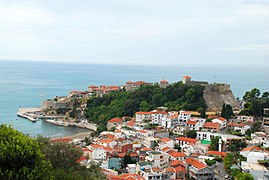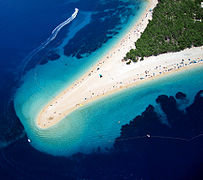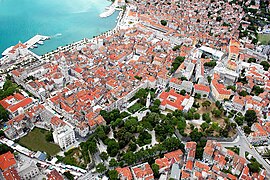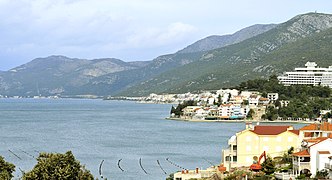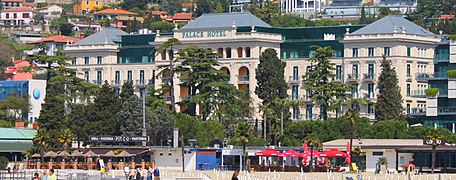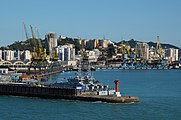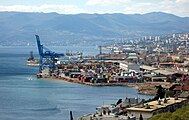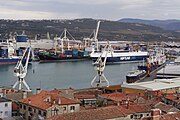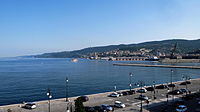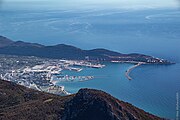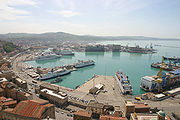Adriatic Sea
| Adriatic Sea | |
|---|---|
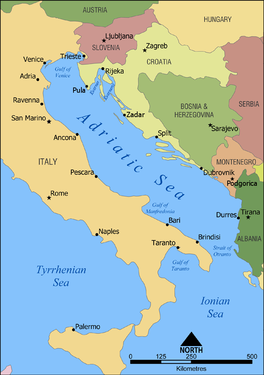 A map of the Adriatic Sea | |
| Location | Southern Europe |
| Coordinates | 43°N 15°E / 43°N 15°E |
| Type | Sea |
| Etymology | From the ancient city of Adria |
| Primary inflows | Adige, Buna, Drin, Krka, Neretva, Po, Soča |
| Primary outflows | Ionian Sea |
| Catchment area | 235,000 km2 (91,000 sq mi) |
| Basin countries | Bordering: Italy, Albania, Croatia, Montenegro, Slovenia, and Bosnia and Herzegovina Not bordering: Greece, Serbia, North Macedonia, Kosovo, Austria, Switzerland and France (drainage basins for inflow rivers)[1] |
| Max. length | 800 km (500 mi) |
| Max. width | 200 km (120 mi) |
| Surface area | 138,600 km2 (53,500 sq mi) |
| Average depth | 252.5 m (828 ft) |
| Max. depth | 1,233 m (4,045 ft) |
| Water volume | 35,000 km3 (2.8×1010 acre⋅ft) |
| Residence time | 3.4±0.4 years |
| Salinity | 38–39 PSU |
| Shore length1 | 3,739.1 km (2,323.4 mi) |
| Max. temperature | 28 °C (82 °F) |
| Min. temperature | 9 °C (48 °F) |
| Islands | Over 1300 |
| Settlements | Ancona, Bari, Durrës, Dubrovnik, Koper, Neum, Pescara, Rijeka, Rimini, Šibenik, Split, Trieste, Venice, Vlorë, Zadar |
| 1 Shore length is not a well-defined measure. | |
The Adriatic Sea (/ˌeɪdriˈætɪk/) is a body of water separating the Italian Peninsula from the Balkan Peninsula. The Adriatic is the northernmost arm of the Mediterranean Sea, extending from the Strait of Otranto (where it connects to the Ionian Sea) to the northwest and the Po Valley. The countries with coasts on the Adriatic are Albania, Bosnia and Herzegovina, Croatia, Italy, Montenegro, and Slovenia.
The Adriatic contains more than 1,300 islands, mostly located along its eastern coast. It is divided into three basins, the northern being the shallowest and the southern being the deepest, with a maximum depth of 1,233 metres (4,045 ft). The prevailing currents flow counterclockwise from the Strait of Otranto. Tidal movements in the Adriatic are slight, although larger amplitudes occur occasionally. The Adriatic's salinity is lower than the Mediterranean's because it collects a third of the fresh water flowing into the Mediterranean, acting as a dilution basin. The surface water temperatures generally range from 30 °C (86 °F) in summer to 12 °C (54 °F) in winter, significantly moderating the Adriatic Basin's climate. The Adriatic Sea sits on the Apulian or Adriatic Microplate. In the Late Oligocene, the Italian Peninsula first formed, separating the Adriatic Basin from the rest of the Mediterranean. The western coast is alluvial or terraced, while the eastern coast is highly indented with pronounced karstification. There are dozens of marine protected areas in the Adriatic, designed to protect the sea's habitats and biodiversity—more than 7,000 species are identified as native to the Adriatic, many of them endemic, rare and threatened ones.
The Adriatic's shores are populated by more than 3.5 million people; the largest cities are Bari, Venice, Trieste and Split. Early settlements on the Adriatic shores were Etruscan, Illyrian, and Greek. By the 2nd century BC, the region was under Rome's control. In the Middle Ages, the sea was controlled, to a varying extent, by a series of states—most notably the Byzantine Empire, the Croatian Kingdom, the Republic of Venice, the Habsburg monarchy and the Ottoman Empire. The Napoleonic Wars resulted in the Austrian Empire gaining control of most of the eastern Adriatic shore and the Po Valley, while the Kingdom of Italy gradually took control of the remaining Italian coast during the 19th century. Following the collapse of Austria-Hungary in 1918, control of the eastern coast passed to Yugoslavia and Albania, which agreed on their maritime boundaries with Italy in 1975 and 1992 respectively. After Yugoslavia's dissolution during the 1990s, its four coastal successor states—Slovenia, Croatia, Bosnia and Herzegovina, and Montenegro—continued to recognise the previous maritime border with Italy, but have disputed the borders between themselves.
Fisheries and tourism are significant sources of income along the Adriatic coast. Maritime transport is also a significant branch of the area's economy—there are 19 seaports in the Adriatic that each handle more than a million tonnes of cargo per year. The largest Adriatic seaport by annual cargo turnover is the Port of Trieste, while the Port of Split is the largest by passengers served per year.
Name
[edit]The origins of the name Adriatic are linked to the Illyrian settlement of Adria, which probably derives its name from Illyrian adur 'water, sea'.[2] In classical antiquity, the sea was known as Mare Adriaticum (Mare Hadriaticum, also sometimes simplified to Adria) or, less frequently, as Mare Superum '[the] upper sea'.[3] The two terms were not synonymous, however. Mare Adriaticum generally corresponds to the Adriatic Sea's extent, spanning from the Gulf of Venice to the Strait of Otranto. That boundary became more consistently defined by Roman authors—early Greek sources place the boundary between the Adriatic and Ionian seas at various places ranging from adjacent to the Gulf of Venice to the southern tip of the Peloponnese, eastern shores of Sicily and western shores of Crete.[4] Mare Superum on the other hand normally encompassed both the modern Adriatic Sea and the sea off the Apennine peninsula's southern coast, as far as the Strait of Sicily.[5] Another name used in the period was Mare Dalmaticum, applied to waters off the coast of Dalmatia or Illyricum.[6] During the early modern period, the entire sea was also known as the Gulf of Venice (Italian: golfo di Venezia),[7] although that name is now informally applied only to the northern area of the sea, from Maestra Point in the Po Delta to Cape Kamenjak on the Istrian Peninsula.
The names for the sea in the languages of the surrounding countries include Albanian: Deti Adriatik; Emilian: Mèr Adriatic; Friulian: Mâr Adriatic; Greek: Αδριατική θάλασσα, romanized: Adriatikí thálassa; Istro Romanian: Marea Adriatică; Italian: Mare Adriatico; Serbo-Croatian: Jadransko more, Јадранско море; Slovene: Jadransko morje; Venetian: Mar Adriàtico. In Serbo-Croatian and Slovene, the sea is often referred to as simply Jadran.
Geography
[edit]The Adriatic Sea is a semi-enclosed sea,[8] bordered in the southwest by the Apennine or Italian Peninsula, in the northwest by the Italian regions of Veneto and Friuli-Venezia Giulia, and in the northeast by Slovenia, Croatia, Bosnia and Herzegovina, Montenegro, and Albania—the Balkan peninsula. In the southeast, the Adriatic Sea connects to the Ionian Sea at the 72-kilometre (45 mi) wide Strait of Otranto.[9] The International Hydrographic Organization (IHO) defines the boundary between the Adriatic and the Ionian seas as a line running from the Butrinto River's mouth (latitude 39°44'N) in Albania to the Karagol Cape in Corfu, through this island to the Kephali Cape (these two capes are in latitude 39°45'N), and on to the Santa Maria di Leuca Cape (latitude 39°48'N).[10] It extends 800 kilometres (500 mi) from the northwest to the southeast and is 200 kilometres (120 mi) wide. It covers 138,600 square kilometres (53,500 sq mi) and has a volume of 35,000 cubic kilometres (8,400 cu mi). The Adriatic extends northwest from 40° to 45°47' north, representing the Mediterranean's northernmost portion.[9] The sea is geographically divided into the Northern Adriatic, Central (or Middle) Adriatic, and Southern Adriatic.[11]
The Adriatic Sea drainage basin encompasses 235,000 square kilometres (91,000 sq mi), yielding a land–sea ratio of 1.8. The drainage basin's mean elevation is 782 metres (2,566 ft) above sea level, with a mean slope of 12.1°.[12] Major rivers discharging into the Adriatic include the Po, Soča, Krka, Neretva, Drin, Buna, and Vjosë.[13][14] In the late 19th century, Austria-Hungary established a geodetic network with an elevation benchmark using the average Adriatic Sea level at the Sartorio pier in Trieste, Italy. The benchmark was subsequently retained by Austria, adopted by Yugoslavia, and retained by the states that emerged after its dissolution.[15][16] In 2016, Slovenia adopted a new elevation benchmark referring to the upgraded tide gauge station in the coastal town of Koper.[17]
The Alps, which also have a large meteorological impact on the Mediterranean, touch the Adriatic in the area around Trieste towards Duino and Barcola.[18]


| Country | Mainland | Islands | Total | Coastal fronta | |
|---|---|---|---|---|---|
| 1,777.3 | 4,058 | 5,835.3 | 526 | ||
| 1,249 | 23b | 1,272 | 926 | ||
| 396 | 10 | 406 | 265 | ||
| 249 | 11 | 260 | 92 | ||
| 46.6 | 0 | 46.6 | 17 | ||
| 21.2 | 0 | 21.2 | 10.5 | ||
| Total | 3,739.1 | 4,102 | 7,841.1 | 1,836.5 | |
| Notes: a The distance between the extreme points of each state's coastline, b Not including islands in coastal lagoons[21] | |||||
| 1.000 mi = 1.609 km; 1.000 km = 0.621 mi | |||||
The Adriatic Sea contains more than 1,300 islands and islets, most along the Adriatic's eastern coast—especially in Croatia, with 1,246 counted.[22] The number includes islands, islets, and rocks of all sizes, including ones emerging at ebb tide only.[23] The Croatian islands include the largest—Cres and Krk, each covering about the same area of 405.78 square kilometres (156.67 sq mi)—and the tallest—Brač, whose peak reaches 780 metres (2,560 ft) above sea level. The islands of Cres and the adjacent Lošinj are separated only by a narrow navigable canal dug in the time of classical antiquity;[24] the original single island was known to the Greeks as Apsyrtides.[25] The Croatian islands include 47 permanently inhabited ones, the most populous among them being Krk, Korčula and Brač.[26] The islands along the Adriatic's western (Italian) coast are smaller and less numerous than those along the opposite coast; the best-known ones are the 117 islands on which the city of Venice is built.[27] The northern shore of the Greek island of Corfu also lies in the Adriatic Sea as defined by the IHO.[28] The IHO boundary places the Diapontia Islands (northwest of Corfu) in the Adriatic Sea.[10][29]
Exclusive economic zone
[edit]Exclusive economic zones in Adriatic Sea:[30]
| Number | Country | Area (Km2) |
|---|---|---|
| 1 | 63,600 | |
| 2 | 55,961 | |
| 3 | 11,105 | |
| 4 | 7,460 | |
| 5 | 192 | |
| 6 | 50 | |
| Total | Adriatic Sea | 138,600 |
Bathymetry
[edit]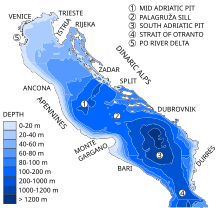
The Adriatic Sea's average depth is 259.5 metres (851 ft), and its maximum depth is 1,233 metres (4,045 ft); however, the North Adriatic basin rarely exceeds a depth of 100 metres (330 ft).[19] The North Adriatic basin, extending between Venice and Trieste towards a line connecting Ancona and Zadar, is only 15 metres (49 ft) deep at its northwestern end; it gradually deepens towards the southeast. It is the largest Mediterranean shelf and is simultaneously a dilution basin and a site of bottom water formation.[31] The Middle Adriatic basin is south of the Ancona–Zadar line, with the 270-metre (890 ft) deep Middle Adriatic Pit (also called the Pomo Depression or the Jabuka Pit). The 170-metre (560 ft) deep Palagruža Sill is south of the Middle Adriatic Pit, separating it from the 1,200-metre (3,900 ft) deep South Adriatic Pit and the Middle Adriatic basin from the South Adriatic Basin. Further on to the south, the sea floor rises to 780 metres (2,560 ft) to form the Otranto Sill at the boundary to the Ionian Sea. The South Adriatic Basin is similar in many respects to the Northern Ionian Sea, to which it is connected.[14] Transversely, the Adriatic Sea is also asymmetric: the Apennine peninsular coast is relatively smooth with very few islands and the Mount Conero and Gargano promontories as the only significant protrusions into the sea; in contrast, the Balkan peninsular coast is rugged with numerous islands, especially in Croatia. The coast's ruggedness is exacerbated by the Dinaric Alps' proximity to the coast, in contrast to the opposite (Italian) coast where the Apennine Mountains are further away from the shoreline.[32]
Hydrology
[edit]
The coastal water dynamics are determined by the asymmetric coasts and the inflow of the Mediterranean seawater through the Straits of Otranto and further on along the eastern coast.[33] The smooth Italian coast (with very few protrusions and no major islands) allows the Western Adriatic Current to flow smoothly, which is composed of the relatively freshwater mass on the surface and the cold and dense water mass at the bottom.[34] The coastal currents on the opposite shore are far more complex owing to the jagged shoreline, several large islands and the proximity of the Dinaric Alps to the shore. The last produces significant temperature variations between the sea and the hinterland, which leads to the creation of local jets.[32] The tidal movement is normally slight, usually remaining below 30 centimetres (12 in). The amphidromic point is at the mid-width east of Ancona.[35]
The normal tide levels are known to increase significantly in a conducive environment, leading to coastal flooding; this phenomenon is most famously known in Italy—especially Venice—as acqua alta. Such tides can exceed normal levels by more than 140 centimetres (55 in),[36] with the highest tide level of 194 centimetres (76 in) observed on 4 November 1966.[37] Such flooding is caused by a combination of factors, including the alignment of the Sun and Moon, meteorological factors such as sirocco related storm surges,[38] and the basin's geometric shape (which amplifies or reduces the astronomical component). Moreover, the Adriatic's long and narrow rectangular shape is the source of an oscillating water motion (French: seiche) along the basin's minor axis.[39] Finally, Venice is increasingly vulnerable to flooding due to coastal area soil subsidence.[40] Such unusually high tides resulting in flooding have also been observed elsewhere in the Adriatic Sea, and have been recorded in recent years in the towns of Koper, Zadar and Šibenik as well.[41][42][43]
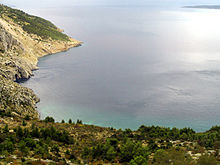
It is estimated that the Adriatic's entire volume is exchanged through the Strait of Otranto in 3.4±0.4 years, a comparatively short period. (For instance, approximately 500 years are necessary to exchange all the Black Sea's water.) This short period is particularly important as the rivers flowing into the Adriatic discharge up to 5,700 cubic metres per second (200,000 cu ft/s). This rate of discharge amounts to 0.5% of the total Adriatic Sea volume, or a 1.3-metre (4 ft 3 in) layer of water each year. The greatest portion of the discharge from any single river comes from the Po (28%),[44] with an average discharge from it alone of 1,569 cubic metres per second (55,400 cu ft/s).[45] In terms of the annual total discharge into the entire Mediterranean Sea, the Po is ranked second, followed by the Neretva and Drin, which rank as third and fourth.[46] Another significant contributor of freshwater to the Adriatic is the submarine groundwater discharge through submarine springs (Croatian: vrulja); it is estimated to comprise 29% of the total water flux into the Adriatic.[47] The submarine springs include thermal springs, discovered offshore near the town of Izola. The thermal spring water is rich with hydrogen sulfide, has a temperature of 22 to 29.6 °C (71.6 to 85.3 °F), and has enabled the development of specific ecosystems.[48] The inflow of freshwater, representing a third of the freshwater volume flowing into the Mediterranean,[14] makes the Adriatic a dilution basin for the Mediterranean Sea.[49] The Middle and South Adriatic Gyres (SAG), are significant cyclonic circulation features, with the former being intermittent and the latter permanent. The SAG measures 150 kilometres (93 miles) in diameter. It contributes to the flow of bottom water from the Adriatic to the Levantine Basin through the Ionian Sea. Through that process, the Adriatic Sea produces most of the East Mediterranean deep water.[50]
Temperature and salinity
[edit]The Adriatic's surface temperature usually ranges from 22 to 30 °C (72 to 86 °F) in the summer, or 12 to 14 °C (54 to 57 °F) in the winter, except along the western Adriatic coast's northern part, where it drops to 9 °C (48 °F) in the winter. The distinct seasonal temperature variations, with a longitudinal gradient in the Northern and transversal gradient in the Middle and Southern Adriatic,[51] are attributed to the continental characteristics of the Adriatic Sea: it is shallower and closer to land than are oceans.[52] During particularly cold winters, sea ice may appear in the Adriatic's shallow coastal areas, especially in the Venetian Lagoon but also in isolated shallows as far south as Tisno (south of Zadar).[53][54] The Southern Adriatic is about 8 to 10 °C (14 to 18 °F) warmer during the winter than the more northerly regions.[55] The Adriatic's salinity variation over the year is likewise distinct:[52] it ranges between 38 and 39 PSUs, somewhat higher than the range of 32 to 37 PSUs for the open ocean.[51] The southern Adriatic is subjected to saltier water from the Levantine Basin.[55]
Climate
[edit]
According to the Köppen climate classification, the upper half of the Adriatic is classified as humid subtropical climate (Cfa), with wetter summers and colder and drier winters, and the southern Adriatic are classified as hot-summer Mediterranean climate (Csa).[56][57] The air temperature can fluctuate by about 20 °C (36 °F) during a season.[51]
The predominant winter winds are the bora and sirocco (called jugo along the eastern coast). The bora is significantly conditioned by wind gaps in the Dinaric Alps bringing cold and dry continental air; it reaches peak speeds in the areas of Trieste, Senj, and Split, with gusts of up to 180 kilometres per hour (97 kn; 110 mph). The sirocco brings humid and warm air, often carrying Saharan sand causing rain dust.[58]
| City | Mean temperature (daily high) | Mean total rainfall | ||||||||
|---|---|---|---|---|---|---|---|---|---|---|
| January | July | January | July | |||||||
| °C | °F | °C | °F | mm | in | days | mm | in | days | |
| Bari | 12.1 | 53.8 | 28.4 | 83.1 | 50.8 | 2.00 | 7.3 | 27.0 | 1.06 | 2.6 |
| Dubrovnik | 12.2 | 54.0 | 28.3 | 82.9 | 95.2 | 3.75 | 11.2 | 24.1 | 0.95 | 4.4 |
| Rijeka | 8.7 | 47.7 | 27.7 | 81.9 | 134.9 | 5.31 | 11.0 | 82.0 | 3.23 | 9.1 |
| Split | 10.2 | 50.4 | 29.8 | 85.6 | 77.9 | 3.07 | 11.1 | 27.6 | 1.09 | 5.6 |
| Venice | 5.8 | 42.4 | 27.5 | 81.5 | 58.1 | 2.29 | 6.7 | 63.1 | 2.48 | 5.7 |
| Source: World Meteorological Organization[59] | ||||||||||
Population
[edit]| Rank | City | Country | Region/County | Population (urban) | ||
|---|---|---|---|---|---|---|
| 1 | Bari | Italy | Apulia | 320,475 | ||
| 2 | Venice | Italy | Veneto | 270,884 | ||
| 3 | Trieste | Italy | Friuli-Venezia Giulia | 205,535 | ||
| 4 | Durrës | Albania | Durrës | 199,073 | ||
| 5 | Split | Croatia | Split-Dalmatia | 178,102 | ||
| 6 | Rimini | Italy | Emilia-Romagna | 150,009 | ||
| 7 | Rijeka | Croatia | Primorje-Gorski Kotar | 128,384 | ||
| 8 | Pescara | Italy | Abruzzo | 123,103 | ||
| 9 | Vlorë | Albania | Vlorë | 117,850 | ||
| 10 | Ancona | Italy | the Marches | 101,210 | ||
| Sources: 2011 Croatian census,[60] Italian National Institute of Statistics (2011),[61] 2011 Albanian Census[62] | ||||||
On the Adriatic Sea's coasts and islands, there are numerous small settlements and a number of larger cities. Among the largest are (counterclockwise) Trieste, Venice, Rimini, Ancona, Pescara and Bari in Italy; Vlorë and Durrës in Albania; Split, Zadar and Rijeka in Croatia; Koper in Slovenia. In total, more than 3.5 million people live on the Adriatic coasts.[63] There are also some larger cities that are located very near the coast, such as the Italian cities of Ravenna and Lecce.
Coastal management
[edit]
Venice, which was originally built on islands off the coast, is most at risk due to subsidence, but the threat is present in the Po delta as well. The causes are a decrease in sedimentation rate due to loss of sediment behind dams, the deliberate excavation of sand for industrial purposes, agricultural use of water, and removal of ground water.[64][65]
The sinking of Venice slowed after artesian wells were banned in the 1960s, but the city remains threatened by the acqua alta floods. Recent studies have suggested that the city is no longer sinking,[66][67] but a state of alert remains in place. In May 2003, then-Prime Minister Silvio Berlusconi inaugurated the MOSE project (Italian: Modulo Sperimentale Elettromeccanico), an experimental model for evaluating the performance of inflatable gates. The project proposes laying a series of 79 inflatable pontoons across the sea bed at the three entrances to the Venetian Lagoon. When tides are predicted to rise above 110 centimetres (43 in), the pontoons will be filled with air and block the incoming water from the Adriatic Sea. This engineering work was due to be completed by 2014,[68] but as of November 2020 is expected to be completed in 2021.[69] Implemented for the first time on October 3, 2020,[69] the barriers are made to seal off three inlets that lead to the Venetian Lagoon and counteract floods of up to ten feet; in addition to protecting the city from flooding, the barrier system is also intended to stabilize Venice's water levels so as to minimize erosion of the brick walls and, subsequently, the foundations of various buildings in the city. However, concern has been raised regarding the frequency of its use—while only necessary a few days a year, the worst-case sea level rise scenario between 2050 and 2100 would prompt deployment up to 187 days a year, essentially cutting off the Venetian Lagoon from the Adriatic Sea. Among other possible adverse effects, this can be expected to lower the lagoon's oxygen levels and trap pollution inside of the city.
Geology
[edit]
Geophysical and geological information indicate that the Adriatic Sea and the Po Valley are associated with a tectonic microplate—identified as the Apulian or Adriatic Plate—that separated from the African Plate during the Mesozoic era. This separation began in the Middle and Late Triassic, when limestone began to be deposited in the area. Between the Norian and Late Cretaceous, the Adriatic and Apulia Carbonate Platforms formed as a thick series of carbonate sediments (dolomites and limestones), up to 8,000 metres (26,000 ft) deep.[70] Remnants of the former are found in the Adriatic Sea, as well as in the southern Alps and the Dinaric Alps, and remnants of the latter are seen as the Gargano Promontory and the Maiella mountain. In the Eocene and early Oligocene, the plate moved north and north-east, contributing to the Alpine orogeny (along with the African and Eurasian Plates' movements) via the tectonic uplift of the Dinarides and Alps. In the Late Oligocene, the motion was reversed and the Apennine Mountains' orogeny took place.[71] An unbroken zone of increased seismic activity borders the Adriatic Sea, with a belt of thrust faults generally oriented in the northeast–southwest direction on the east coast and the northeast–southwest normal faults in the Apennines, indicating an Adriatic counterclockwise rotation.[72]
An active 200-kilometre (120 mi) fault has been identified to the northwest of Dubrovnik, adding to the Dalmatian islands as the Eurasian Plate slides over the Adriatic microplate. Furthermore, the fault causes the Apennine peninsula's southern tip to move towards the opposite shore by about 0.4 centimetres (0.16 in) per year. If this movement continues, the seafloor will be completely consumed and the Adriatic Sea closed off in 50–70 million years.[73] In the Northern Adriatic, the coast of the Gulf of Trieste and western Istria is gradually subsiding, having sunk about 1.5 metres (4 ft 11 in) in the past two thousand years.[74] In the Middle Adriatic Basin, there is evidence of Permian volcanism in the area of Komiža on the island of Vis and the volcanic islands of Jabuka and Brusnik.[75] Earthquakes have been observed in the region since the earliest historical records.[76] A recent strong earthquake in the region was the 1979 Montenegro earthquake, measuring 7.0 on the Richter scale.[77] Historical earthquakes in the area include the 1627 Gargano peninsula and the 1667 Dubrovnik earthquakes, both followed by strong tsunamis.[78] In the last 600 years, fifteen tsunamis have occurred in the Adriatic Sea.[79]
Seafloor sediment
[edit]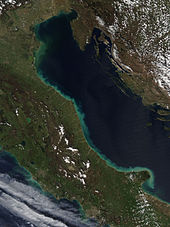
All types of seafloor sediments are found in the Adriatic Sea. The Northern Adriatic's comparatively shallow seabed is characterised by relict sand (from times when the water level was lower and the area was a sandy beach), while a muddy bed is typical at depths below 100 metres (330 ft).[33][80] There are five geomorphological units in the Adriatic: the Northern Adriatic (up to 100 metres (330 ft) deep); the North Adriatic islands area protected against sediments filling it in by outer islands (pre-Holocene karst relief); the Middle Adriatic islands area (large Dalmatian islands); the Middle Adriatic (characterized by the Middle Adriatic Depression); and the Southern Adriatic consisting of a coastal shelf and the Southern Adriatic Depression. Sediments deposited in the Adriatic Sea today generally come from the northwest coast, being carried by the Po, Reno, Adige, Brenta, Tagliamento, Piave and Soča rivers. The volume of sediments carried from the eastern shore by the Rječina, Zrmanja, Krka, Cetina, Ombla, Dragonja, Mirna, Raša and Neretva rivers is negligible, because these sediments are mostly deposited at the river mouths. The Adriatic's western shores are largely either alluvial or terraced, whereas the eastern shores are predominantly rocky, except for the southernmost part of the shore located in Albania that consists of sandy coves and rocky capes.[71]
Coasts
[edit]
The eastern Adriatic shore's Croatian part is the most indented Mediterranean coastline.[81] Most of the eastern coast is characterised by a karst topography, developed from the Adriatic Carbonate Platform's exposure to weathering. Karstification there largely began after the Dinarides' final uplift in the Oligocene and the Miocene, when carbonate deposits were exposed to atmospheric effects; this extended to the level of 120 metres (390 ft) below the present sea level, exposed during the Last Glacial Maximum. It is estimated that some karst formations are from earlier sea level drops, most notably the Messinian salinity crisis.[70] Similarly, karst developed in Apulia from the Apulian Carbonate Platform.[82]

The largest part of the eastern coast consists of carbonate rocks, while flysch (a particular type of sedimentary rock) is significantly represented in the Gulf of Trieste coast, especially along Slovenia's coast where the 80-metre (260 ft) Strunjan cliff—the highest cliff on the entire Adriatic and the only one of its type on the eastern Adriatic coast—is located,[83] on the Kvarner Gulf coast opposite Krk, and in Dalmatia north of Split.[84] Rocks of the same type are found in Albania and on the western Adriatic coast.[85][86]
There are alternations of maritime and alluvial sediments occurring in the Po Valley, at the Adriatic's north-west coast, and as far west as Piacenza, dating to the Pleistocene as the sea advanced and receded over the valley. An advance began after the Last Glacial Maximum, which brought the Adriatic to a high point at about 5,500 years ago.[87] Since then, the Po delta has been prograding (expanding/extending). The rate of coastal zone progradation between 1000 BC and 1200 AD was 4 metres (13 ft) per year.[88] In the 12th century, the delta advanced at a rate of 25 metres (82 ft) per year. In the 17th century, the delta began to become a human-controlled environment, as the excavation of artificial channels started; the channels and new distributaries of the Po have been prograding at rates of 50 metres (160 ft) per year or more since then.[89] There are more than 20 other rivers flowing into the Adriatic Sea in Italy alone, also forming alluvial coastlines,[90] including the lagoons of Venice, Grado and Caorle.[91] There are smaller eastern Adriatic alluvial coasts—in the deltas of the Dragonja,[92] Buna and Neretva rivers.[93][94]
Biogeography and ecology
[edit]The Adriatic Sea is a unique water body in respect of its overall biogeochemical physiognomy. It exports inorganic nutrients and imports particulate organic carbon and nitrogen through the Strait of Otranto—acting as a mineralization site. The exchange of the substances is made more complex by bathymetry of the Adriatic Sea—75% of water flowing north through the strait recirculates at the Palagruža Sill and North Adriatic adds no more than 3–4% of water to the South Adriatic.[95] This is reflected in its biogeography and ecology, and particularly in the composition and properties of its ecosystems.[96] Its main biogeographic units are the Northern Adriatic, the Central Adriatic, and the Southern Adriatic.[97]
Flora and fauna
[edit]The unique nature of the Adriatic gives rise to an abundance of endemic flora and fauna. The Croatian National Biodiversity Strategy Action Plan identified more than 7,000 animal and plant species in the Adriatic Sea. The Central Adriatic is especially abundant in endemic plant species, with 535 identified species of green, brown and red algae.[98] Four out of five Mediterranean seagrass species are found in the Adriatic Sea. The most common species are Cymodocea nodosa and Zostera noltii, while Zostera marina and Posidonia oceanica are comparatively rare.[99]
A number of rare and threatened species are also found along the Adriatic's eastern coast; it is relatively clearer and less polluted than the western Adriatic coast—in part because the sea currents flow through the Adriatic in a counterclockwise direction, thus bringing clearer waters up the eastern coast and returning increasingly polluted water down the western coast. This circulation has significantly contributed to the biodiversity of the countries along the eastern Adriatic coast; the common bottlenose dolphin is frequent in the eastern coast's waters only, and the Croatian coast provides refuge for the critically endangered monk seal and sea turtles.[98] Recent studies revealed that cetaceans and other marine megafaunas, that were once thought to be vagrants to Adriatic Sea, migrate and live in the semi-closed sea on larger scales.[100] Largest of these live normally is the fin whale,[101] and sperm whale,[102] the largest of toothed whales also migrate but less common than fin whales, followed by Cuvier's beaked whales.[100] Basking sharks[103] and manta rays are some of migrant species to the sea.[104][105][106] Historical presences of depleted or extinct species such as North Atlantic right whales (extinct or functionally extinct), Atlantic gray whales (extinct), and humpback whales have been speculated as well.[107]
Tuna has been caught by the locals in the upper Adriatic for thousands of years. The very large schools consisted mainly of little tunny and moved as far as the Gulf of Trieste. However, increasing fishing prevented the migration of large schools of fish to the north. The last major tuna catch was made there in 1954 by the fishermen from Santa Croce, Contovello and Barcola.[108]
The Northern Adriatic in particular is rich in endemic fish fauna.[14] Around thirty species of fish are found in only one or two countries bordering the Adriatic Sea. These are particularly due to or dependent upon the karst morphology of the coastal or submarine topography; this includes inhabiting subterranean habitats, karst rivers, and areas around freshwater springs.[109] There are 45 known subspecies endemic to the Adriatic's coasts and islands. In the Adriatic, there are at least 410 species and subspecies of fish, representing approximately 70% of Mediterranean taxa, with at least 7 species endemic to the Adriatic. Sixty-four known species are threatened with extinction, largely because of overfishing.[98] Only a small fraction of the fish found in the Adriatic are attributed to recent processes such as Lessepsian migration, and escape from mariculture.[110]
Protected areas
[edit]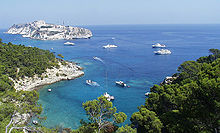
The biodiversity of the Adriatic is relatively high, and several marine protected areas have been established by countries along its coasts. In Italy, these are Miramare in the Gulf of Trieste (in the Northern Adriatic), Torre del Cerrano and Tremiti Islands in the Middle Adriatic basin and Torre Guaceto in southern Apulia.[111][112] The Miramare protected area was established in 1986 and covers 30 hectares (74 acres) of coast and 90 hectares (220 acres) of sea. The area encompasses 1.8 kilometres (1.1 mi) of coastline near the Miramare promontory in the Gulf of Trieste.[113] The Torre del Cerrano protected area was created in 2009, extending 3 nautical miles (5.6 km; 3.5 mi) into the sea and along 7 kilometres (4.3 mi) of coastline. Various zones of the protected area cover 37 square kilometres (14 sq mi) of sea surface.[114] The Tremiti Islands reserve has been protected since 1989, while the Tremiti islands themselves are part of the Gargano National Park.[115] The Torre Guaceto protected area, located near Brindisi and Carovigno, covers a sea surface of 2,227 hectares (5,500 acres) and is adjacent to the Torre Guaceto State Reserve covering 1,114 hectares (2,750 acres) of coast and sharing an 8-kilometre (5.0 mi) coastline with the marine protected area.[116] Furthermore, there are 10 internationally important (Ramsar) wetland reserves in Italy located along the Adriatic coast.[117]
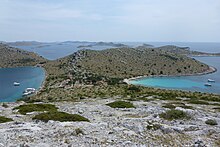
There are seven marine protected areas in Croatia: Brijuni and the Lim Canal off the Istria peninsula's coast, near Pula and Rovinj respectively; Kornati and Telašćica in the Middle Adriatic basin, near Zadar; and Lastovo, Bay of Mali Ston (Croatian: Malostonski zaljev) and Mljet in southern Dalmatia.[111] The Brijuni national park encompasses the 743.3-hectare (1,837-acre) archipelago itself and 2,651.7 hectares (6,552 acres) of surrounding sea;[118] it became a national park in 1999.[119] The Lim Canal is a 10-kilometre (6.2 mi) ria of the Pazinčica river.[120] The Kornati national park was established in 1980; it covers approximately 220 square kilometres (85 sq mi), including 89 islands and islets. The marine environment encompasses three-quarters of the total area, while the island shores' combined length equals 238 kilometres (148 mi).[121] Telašćica is a nature park established on Dugi Otok in 1988. The park covers 69 kilometres (43 mi) of coastline, 22.95 square kilometres (8.86 sq mi) of land and 44.55 square kilometres (17.20 sq mi) of sea.[122] The Bay of Mali Ston is located at the border of Croatia and Bosnia–Herzegovina, north of the Pelješac peninsula. The marine protected area covers 48 square kilometres (19 sq mi).[111] The Lastovo nature park was established in 2006, and it includes 44 islands and islets, 53 square kilometres (20 sq mi) of land and 143 square kilometres (55 sq mi) of sea surface.[123] The Mljet national park was established in 1960, covering a 24-square-kilometre (9.3 sq mi) marine protection area.[111] In addition, there is a Ramsar wetland reserve in Croatia—the Neretva river's delta.[124]
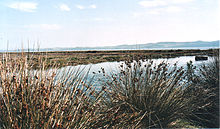
In Slovenia, the marine and coastal protected nature areas are the Sečovlje Salina Landscape Park, Strunjan Landscape Park, Škocjan Inlet Nature Reserve, and the Debeli Rtič, Cape Madona and Lakes in Fiesa natural monuments.[125][126] The Sečovlje Salina Landscape Park was established in 1990, covers 721 hectares (1,780 acres), and includes four nature reserves.[127][128] In 1993, the area was designated a Ramsar site;[125] it is also a site of international importance for waterbird species.[129] The 429-hectare (1,060-acre) Strunjan Landscape Park was established in 2004 and comprises two nature reserves.[125][127] It includes a 4 kilometres (2.5 mi) long cliff, the northernmost Mediterranean salt field and the only Slovenian lagoon system.[130] It is also the northernmost point of growth of some Mediterranean plant species.[131] The Škocjan Inlet Nature Reserve was established in 1998 and covers 122 hectares (300 acres).[132] The Debeli Rtič natural monument covers 24 hectares (59 acres),[133] the Cape Madona natural monument covers 12 hectares (30 acres),[134] and the Lakes in Fiesa natural monument, with the coastal lake as the only brackish lake in Slovenia,[135] covers 2.1 hectares (5.2 acres).[136]
In 2010, Albania established its first marine protection area, the Karaburun-Sazan National Marine Park at the Karaburun Peninsula where the Adriatic and Ionian Seas meet. The park covers a total of 12,570 hectares (31,100 acres).[137] Two additional marine protection areas are planned in Albania: the Cape of Rodon (Albanian: Kepi i Rodonit) and Porto Palermo.[111] In addition, Albania is home to two Ramsar wetland reserves: Karavasta Lagoon, and Butrint.[138] Neither Bosnia–Herzegovina nor Montenegro have or plan to establish any marine protection areas.[111]
Pollution
[edit]The Adriatic Sea ecosystem is threatened by excessive input of nutrients through drainage from agricultural land and wastewater flowing from cities; this includes both along its coast and from rivers draining into the sea—especially from the Po River.[139] Venice is often cited as an example of polluted coastal waters where shipping, transportation, farming, manufacturing and wastewater disposal contribute to polluting the sea.[140] A further risk is presented by ballast water discharge by ships, especially tankers. Still, since most of the cargo handled by the Adriatic ports, and virtually all liquid (tanker) cargo handled by the ports, is coming to—not coming from—the Adriatic Basin, the risk from ballast water (from tankers expelling ballast water then loading in the Adriatic) remains minimal. However, proposed export oil pipelines were objected to specifically because of this issue. Oil spills are a major concern in terms of potential environmental impact and damage to tourism and fisheries.[141] It is estimated that if a major oil spill happened, a million people would lose their livelihoods in Croatia alone.[142] An additional risk is presented by oil refineries in the Po River basin where oil spills have occurred before,[143] in addition to accidents occurring in the Adriatic already, so far with no significant environmental consequences.[144] Since 2006, Italy has been considering the construction of an offshore and an onshore LNG terminal in the Gulf of Trieste, as well as a pipeline, in the immediate vicinity of the Slovenian–Italian border.[145] The Slovenian government and municipalities,[146] the municipal council of Trieste,[147] and non-governmental organisations have voiced concern over their environmental hazards, effect on transport and effect on tourism.[148][149]
Another source of pollution of the Adriatic is solid waste. Drifting waste—occasionally relatively large quantities of material, especially waste plastic—is transported northwest by the sirocco.[150] Air pollution in the Adriatic Basin is associated with the large industrial centres in the Po River valley and the large industrial cities along the coast.[151][152]
Italy and Yugoslavia established a joint commission to protect the Adriatic Sea from pollution in 1977; the organization later changed with Slovenia, Croatia and Montenegro replacing Yugoslavia.[153] Future pollution hazards are addressed and pollution hotspots are assessed not only by nations in the basin but also through regional projects with World Bank support. 27 such hotspots have been determined as of 2011, 6 warranting an urgent response.[154]
History
[edit]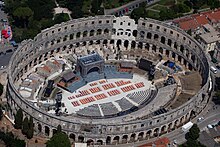
Settlements along the Adriatic dating to between 6100 and 5900 BC appear in Albania and Dalmatia on the eastern Adriatic coast, related to the Cardium pottery culture.[155] During classical antiquity, Illyrians inhabited the eastern coast,[156] and the western coast was inhabited by the peoples of Ancient Italy, mainly Etruscans, before the Roman Republic's rise.[157] Greek colonisation of the Adriatic dates back to the 7th and 6th centuries BC when the ancient cities of Epidamnos and Apollonia were founded. The Greeks soon expanded further north establishing several cities, including Ancona, Black Corcyra, Epidaurus, Issa, with trade established as far north as the Po River delta, where an emporium (trading station) was founded in Adria.[158]
Roman era
[edit]Roman economic and military influence in the region began to grow with the creation by 246 BC of a major naval base at Brundisium (now Brindisi), which was established to bar Carthaginian ships from the Adriatic during the Punic Wars. This led to conflict with the Illyrians, who lived in a collection of semi-Hellenized kingdoms that covered much of the Balkans and controlled the eastern shore of the sea, resulting in the Illyrian Wars from 229 to 168 BC. The initial Roman intervention in 229 BC, motivated in part by a desire to suppress Illyrian piracy in the Adriatic, marked the first time that the Roman navy crossed that sea to launch a military campaign.[159][160] Those wars ended with the eastern shore becoming a province of the Roman Republic.[161] However, resistance to Roman rule continued sporadically and Rome did not completely consolidate control of the region until Augustus's general Tiberius put down the Great Illyrian Revolt, a bitter struggle waged from 6 to 9 AD.[160][162] Following the repression of the revolt the Roman province of Illyricum was split into Dalmatia and Pannonia. Most of the eastern shore of the Adriatic was part of Dalmatia, except for the southernmost portion, part of the province of Macedonia, and the peninsula of Istria on the northern part of the eastern shore; Istria contained the important Roman colony at Pula and was incorporated into the province of Italy.[citation needed]
During the Roman period, Brundisium, on the western shore, and Apollonia and Dyrrachium (originally called Epidamnos, now Durrës in Albania) on the eastern shore became important ports. Brundisium was linked by the Via Appia road to the city of Rome, and Dyrrachium and Apollonia were both on the Via Egnatia, a road that by about 130 BC the Romans had extended eastward across the Balkans to Byzantium (later Constantinople, now Istanbul).[163][164] This made the sea passage across the Adriatic between Brundisium and Dyrrachium (or Apollonia) a link in the primary route for travelers, trade, and troop movements, between Rome and the East. This route played a major role in some of the military operations that marked the end of the Roman Republic and the start of the imperial period. Sulla used it during the First Mithridatic War.[165] During Caesar's Civil War, there was a three-month delay in Caesar's Balkan campaign against Pompey caused when winter storms on the Adriatic and a naval blockade held up Mark Antony from reaching him from Brundisium with reinforcements; after the reinforcements finally arrived Caesar made an unsuccessful attempt to capture Dyrrachium before the campaign moved inland.[166] Marc Antony and Octavian (later Augustus) crossed the Adriatic to Dyrrachium with their armies in their campaign against two of Caesar's assassins, Brutus and Cassius, that culminated in the Battle of Philippi.[167] Brundisium and Dyrrachium remained important ports well after the Roman period, but an earthquake in the 3rd century AD changed the path of a river causing Apollonia's harbor to silt up, and the city to decline.[168]
Another city on the Italian coast of the Adriatic that increased in importance during the Roman era was Ravenna. During the reign of Augustus, it became a major naval base as part of his program to re-organize the Roman navy to better protect commerce in the Mediterranean.[169] During the 4th century AD the emperors of the Western Roman Empire had moved their official residence north from Rome to Mediolanum (now Milan) in order to be better able to control the military frontier with the Germanic tribes. In 402 AD, during a period of repeated Germanic invasions of Italy, the capital was shifted to Ravenna because nearby marshes made it more defensible, and the Adriatic provided an easy escape path by sea.[170] When the Western Empire fell in 476 AD Ravenna became the capital of the Ostrogothic Kingdom of Italy.[171]
Middle Ages
[edit]
In the Early Middle Ages, after the Roman Empire's decline, the Adriatic's coasts were ruled by Ostrogoths, Lombards and the Byzantine Empire.[172][173] The Ostrogothic Kingdom ruled Italy following the fall of the Western Roman Empire in 476 AD. However, during the reign of Justinian the Byzantine Empire sent an army under the general Belisarius to regain control of Italy, resulting in the Gothic War (535–554). The Byzantines established the Exarchate of Ravenna and by 553 AD their viceroy (Exarch) ruled almost the entire Italian peninsula from that city. In 568 AD the Lombards invaded northern Italy, and over the course of the next century or so the importance of the Exarchate declined as the territory under Lombard control expanded and as the Byzantine outpost of Venice became increasingly independent. In 752 AD the Lombards overthrew the Exarchate, ending the influence of the Byzantine Empire on the western shore of the Adriatic for a few centuries.[174]
The last part of the period saw the rise of the Carolingian Empire and then the Frankish Kingdom of Italy, which controlled the Adriatic Sea's western coast,[175] while Byzantine Dalmatia on the east coast gradually shrunk into Dalmatian city-states following the Avar and Croatian invasions starting in the 7th century.[176] The Republic of Venice, one of the maritime republics, was founded during this period and went on to become a significant maritime power after receiving a Byzantine tax exemption in 1082.[177] The end of the period brought about the Holy Roman Empire's control over the Kingdom of Italy (which would last until the Peace of Westphalia in 1648),[178] the establishment of an independent Kingdom of Croatia and the Byzantine Empire's return to the southern Apennine peninsula.[179][180] In addition, the Papal States were carved out in the area around Rome and central Italy in the 8th century.[181]

The High Middle Ages in the Adriatic Sea basin saw further territorial changes, including the Norman conquest of southern Italy ending the Byzantine presence on the Apennine peninsula in the 11th and 12th centuries (the territory would become the Kingdom of Naples in 1282)[182][183] and the control of a substantial part of the eastern Adriatic coast by the Kingdom of Hungary after a personal union was established between Croatia and Hungary in 1102.[184] In this period, the Republic of Venice began to expand its territory and influence.[185] In 1202, the Fourth Crusade was diverted to conquer Zadar at the behest of the Venetians—the first instance of a Crusader force attacking a Catholic city—before proceeding to sack Constantinople.[186] In the 13th century, Venice established itself as a leading maritime nation. During much of the 12th and 13th centuries, Venice and the Republic of Genoa were engaged in warfare culminating in the War of Chioggia, ousting the Genoese from the Adriatic.[187] Still, the 1381 Treaty of Turin that ended the war required Venice to renounce claims to Dalmatia, after losing the territory to Hungary in 1358. In the same year, the Republic of Ragusa was established in Dubrovnik as a city-state after it was freed from Venetian suzerainty.[188]
Venice regained Dalmatia in 1409 and held it for nearly four hundred years, with the republic's apex of trading and military power in the first half of the 15th century.[189] The 15th and the 16th centuries brought about the Byzantine Empire's destruction in 1453 and the Ottoman Empire's expansion that reached Adriatic shores in present-day Albania and Montenegro as well as the immediate hinterland of the Dalmatian coast,[190][191] defeating the Hungarian and Croatian armies at Krbava in 1493 and Mohács in 1526.[192] These defeats spelled the end of an independent Hungarian kingdom, and both Croatian and Hungarian nobility chose Ferdinand I of the House of Habsburg as their new ruler, bringing the Habsburg monarchy to the shore of the Adriatic Sea, where it would remain for nearly four hundred years.[193] The Ottomans and Venetians fought a series of wars, but until the 17th century these were not fought in the Adriatic area.[194] Ottoman raids on the Adriatic coasts effectively ceased after the massive setback in the Battle of Lepanto in October 1571.[195]
Early modern period
[edit]
[196] The 17th century's final territorial changes were caused by the Morean or Sixth Ottoman–Venetian War, when in 1699 Venice slightly enlarged its possessions in Dalmatia.[197] In 1797, the Republic of Venice was abolished after the French conquest.[198] The Venetian territory was then handed over to Austria and briefly ruled as part of the Archduchy of Austria. The territory was turned back over to France after the Peace of Pressburg in 1805 when the territory in the Po valley became an integral part of the new Napoleonic Kingdom of Italy.[199] The new kingdom included the province of Romagna, thus removing the Papal State from the Adriatic coast;[200] however, Trieste, Istria and Dalmatia were joined into a set of separate provinces of the French Empire: the Illyrian Provinces.[199] These were created in 1809 through the Treaty of Schönbrunn; they represented the end of Venetian rule on the eastern Adriatic coast, as well as the end of the Republic of Ragusa.[201] The Adriatic Sea was a minor theatre in the Napoleonic Wars; the Adriatic campaign of 1807–1814 involved the British Royal Navy contesting the Adriatic's control by the combined navies of France, Italy and the Kingdom of Naples. During the campaign, the Royal Navy occupied Vis and established its base there in Port St. George.[202] The campaign reached its climax in the 1811 Battle of Lissa,[citation needed] and ended with British and Austrian troops seizing the coastal cities on the eastern Adriatic coast from the French.[203] Days before the Battle of Waterloo, the Congress of Vienna awarded the Illyrian Provinces (spanning from the Gulf of Trieste to the Bay of Kotor) to Austria.[204] The Congress of Vienna also created the Kingdom of Lombardy–Venetia which encompassed the city of Venice, the surrounding coast and a substantial hinterland, and was controlled by Austria.[205] In the Apennine peninsula's south, the Kingdom of the Two Sicilies was formed in 1816 by unifying the kingdoms of Naples and Sicily.[206]
Modern period
[edit]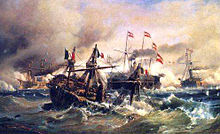
The process of Italian unification culminated in the Second Italian War of Independence, resulting in the Kingdom of Sardinia annexing all territories along the western Adriatic coast south of Venetia in 1860, and the 1861 establishment of the Kingdom of Italy in its place. The Kingdom of Italy expanded in 1866: it annexed Venetia,[207] but its navy was defeated in the Adriatic near Vis.[208] Following the Austro-Hungarian Compromise of 1867 and the Croatian–Hungarian Settlement of 1868, the control of much of the eastern Adriatic coast was redefined. The cisleithanian (Austrian) part of Austria-Hungary spanned from the Austrian Littoral to the Bay of Kotor, with the exception of the Croatian Littoral mainland. In the territory outside the Austrian Littoral, special status was given to Fiume (modern-day Rijeka) as a separate part of the Kingdom of Hungary. The rest of the territory was made a part of the Kingdom of Croatia-Slavonia, which in turn was also in the Transleithanian part of the dual monarchy.[184] The Adriatic coastline controlled by the Ottoman Empire was reduced by the Congress of Berlin in 1878, through recognition of the independence of the Principality of Montenegro, which controlled the coast south of the Bay of Kotor to the Bojana River.[209] The Ottoman Empire lost all territories along the Adriatic following the First Balkan War and consequent 1913 Treaty of London that established an independent Albania.[210]
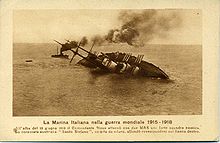
The World War I Adriatic Campaign was largely limited to blockade attempts by the Allies and the effort of the Central Powers to thwart the British, French and Italian moves.[211] Italy joined the Allies in April 1915 with the Treaty of London, which promised Italy the Austrian Littoral, northern Dalmatia, the port of Vlorë, most of the eastern Adriatic islands and Albania as a protectorate.[212] The treaty provided the basis for all the following divisions between Italy and Yugoslavia.[213] In 1918, the Montenegrin national assembly voted to unite with the Kingdom of Serbia, giving the latter access to the Adriatic.[214] Another short-lived, unrecognised state established in 1918 was the State of Slovenes, Croats and Serbs, formed from parts of Austria-Hungary, comprising most of the former monarchy's Adriatic coastline. Later that year, the Kingdom of Serbia and the State of Slovenes, Croats and Serbs formed the Kingdom of Serbs, Croats and Slovenes—subsequently renamed Yugoslavia. The proponents of the new union in the Croatian parliament saw the move as a safeguard against Italian expansionism as stipulated in the Treaty of London.[215] The treaty was largely disregarded by Britain and France because of conflicting promises made to Serbia and a perceived lack of Italian contribution to the war effort outside Italy itself.[216] The 1919 Treaty of Saint-Germain-en-Laye did transfer the Austrian Littoral and Istria to Italy but awarded Dalmatia to Yugoslavia.[217] Following the war, a private force of demobilized Italian soldiers seized Rijeka and set up the Italian Regency of Carnaro—seen as a harbinger of Fascism—in order to force the recognition of Italian claims to the city.[218] After sixteen months of the Regency's existence, the 1920 Treaty of Rapallo redefined the Italian–Yugoslav borders, among other things transferring Zadar and the islands of Cres, Lastovo and Palagruža to Italy, securing the island of Krk for Yugoslavia and establishing the Free State of Fiume; this new state was abolished in 1924 by the Treaty of Rome that awarded Fiume (modern Rijeka) to Italy and Sušak to Yugoslavia.[219]
Late 20th century
[edit]
During World War II, the Adriatic saw only limited naval action, starting with the Italian invasion of Albania and the joint Axis invasion of Yugoslavia. The latter led to the annexation of a large part of Dalmatia and nearly all the eastern Adriatic islands by Italy and the establishment of two puppet states, the Independent State of Croatia and the Kingdom of Montenegro, which controlled the remainder of the former Yugoslav Adriatic coast.[220] In 1947, after the Armistice between Italy and Allied armed forces and the war's end, Italy (now a republic) and the Allies signed the Treaty of Peace with Italy. The treaty reversed all wartime annexations, guaranteed the independence of Albania, created the Free Territory of Trieste (FTT) as a city-state, and gave communist Yugoslavia most of the Slovenian Littoral, as well as Istria, the islands of Cres, Lastovo and Palagruža, and the cities of Zadar and Rijeka.[221] The FTT was partitioned in 1954: Trieste itself and the area to the North of it were placed under Italian control, while the rest came under Yugoslav control. This arrangement was made permanent in the 1975 Treaty of Osimo.[222]
During the Cold War, the Adriatic Sea became the southernmost flank of the Iron Curtain as Italy joined NATO,[223] while the Warsaw Pact established bases in Albania.[224] After the fall of communism, Yugoslavia broke apart: Slovenia and Croatia declared independence in 1991,[225] and Bosnia–Herzegovina followed in 1992,[226] while Montenegro remained in a federation with Serbia, officially called Serbia and Montenegro.[227] The ensuing Croatian War of Independence included limited naval engagements and a blockade of Croatia's coast by the Yugoslav Navy,[228] leading to the Battle of the Dalmatian channels and a later withdrawal of Yugoslav vessels.[229] Montenegro declared itself independent in 2006, effectively land-locking Serbia.[227] The period also saw the Adriatic Sea as the theatre of several NATO operations, including the blockade of Yugoslavia,[citation needed] intervention in Bosnia and Herzegovina and the 1999 bombing of Yugoslavia.[230][231]
Boundaries
[edit]Italy and Yugoslavia defined their Adriatic continental shelf delimitation in 1968,[232] with an additional agreement signed in 1975 on the Gulf of Trieste boundary, following the Treaty of Osimo. The boundary agreed in 1968 extends 353 nautical miles (654 km; 406 mi) and consists of 43 points connected by straight lines or circular arc segments. The additional boundary agreed upon in 1975 consists of 5 points, extending from an end point of the 1968 line. All successor states of former Yugoslavia accepted the agreements. In the Adriatic's southernmost areas the border was not determined in order to avoid prejudicing the location of the tripoint with the Albanian continental shelf border, which remains undefined. Before the breakup of Yugoslavia, Albania, Italy and Yugoslavia initially proclaimed 15-nautical-mile (28 km; 17 mi) territorial waters, subsequently reduced to international-standard 12 nautical miles (22 km; 14 mi) and all sides adopted baseline systems (mostly in the 1970s). Albania and Italy determined their sea border in 1992 according to the equidistance principle.[233] Following Croatian EU membership, the Adriatic became an internal sea of the EU.[234] The United Nations Convention on the Law of the Sea defines the Adriatic Sea as an enclosed or semi-enclosed sea.[235]
Adriatic Euroregion
[edit]
The Adriatic Euroregion was established in Pula in 2006 to promote trans-regional and trans-national cooperation in the Adriatic Sea area and serve as an Adriatic framework to help resolve issues of regional importance. The Adriatic Euroregion consists of 23 members: the Apulia, Molise, Abruzzo, the Marches, Emilia-Romagna, Veneto and Friuli-Venezia Giulia regions of Italy; the municipality of Izola in Slovenia; the Istria, Primorje-Gorski Kotar, Lika-Senj, Zadar, Šibenik-Knin, Split-Dalmatia and Dubrovnik-Neretva counties of Croatia; the Herzegovina-Neretva Canton of Bosnia–Herzegovina; the municipalities of Kotor and Tivat in Montenegro; the Fier, Vlorë, Tirana, Shkodër, Durrës and Lezhë counties of Albania; and the Greek prefectures of Thesprotia and Corfu.[236]
Disputes
[edit]The former Yugoslav republics' land borders were decided by demarcation commissions implementing the AVNOJ decisions of 1943 and 1945,[237][238] but the exact course has not been agreed upon by the successor states, which makes the maritime boundaries' definition difficult;[239] the maritime borders were not defined at all in the time of Yugoslavia.[240] In addition, the maritime boundary between Albania and Montenegro was not defined before the 1990s.[233]
Croatia and Slovenia started negotiations to define maritime borders in the Gulf of Piran in 1992 but failed to agree, resulting in a dispute. Both countries also declared their economic zones, which partially overlap.[233][241] Croatia's application to become an EU member state was initially suspended pending resolution of its border disputes with Slovenia.[233] These disputes with Slovenia were eventually settled with an agreement to accept the decision of an international arbitration commission set up via the UN, enabling Croatia to progress towards EU membership.[242][243][244] Croatia is still not following the resolution of the international arbitration for the Gulf of Piran. A dispute over the gulf is still on going with the Croatians handing out fines to Slovenian fishermen that are following the agreed economic.[245] Aside from the EU membership difficulty, even before its settling the dispute has caused no major practical problems.[233]
The maritime boundary between Bosnia–Herzegovina and Croatia was formally settled in 1999, but a few issues are still in dispute—the Klek peninsula and two islets in the border area. The Croatia–Montenegro maritime boundary is disputed in the Bay of Kotor, at the Prevlaka peninsula. This dispute was exacerbated by the peninsula's occupation by the Yugoslav People's Army and later by the (Serbian–Montenegrin) FR Yugoslav Army, which in turn was replaced by a United Nations observer mission that lasted until 2002. Croatia took over the area with an agreement that allowed Montenegrin presence in the bay's Croatian waters, and the dispute has become far less contentious since Montenegro's independence in 2006.[233]
Economy
[edit]Fishing
[edit]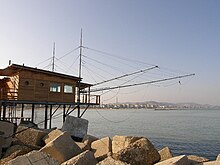
The Adriatic Sea fishery's production is distributed among countries in the basin.[246] In 2000, the nominal—on a live weight basis—total landings of all Adriatic fisheries reached 110,000 tonnes (108,000 long tons).[247] Overfishing is a recognised problem—450 species of fish live in the Adriatic Sea, including 120 species threatened by excessive commercial fishing, a problem exacerbated by pollution and global warming. Overexploited species include common dentex, red scorpionfish, monkfish, John Dory, blue shark, spiny dogfish,[248] mullet, red mullet, Norway lobster,[249] as well as European hake,[250] and sardines.[251] Turtles and common bottlenose dolphins are also being killed by fishing nets. The depleted fish stock, and Croatia's Ecological and Fisheries Protection Zone (ZERP) contributed to accusations of overfishing exchanged between Italian and Croatian fishermen.[248] ZERP was introduced in 2003, but its application to EU member states was suspended in 2004.[234] The depleted stocks of fish are being addressed through a new proposed EU fisheries policy that was scheduled to take effect in 2013, when Croatia acceded to the EU,[252] and restore the stocks to sustainable levels by 2015.[253]
The largest volume of fish harvesting was in Italy, where the total production volume in 2007 stood at 465,637 tonnes (458,283 long tons).[246] In 2003, 28.8% of Italian fisheries production volume was generated in the Northern and central Adriatic, and 24.5% in Apulia (from the Southern Adriatic and Ionian Sea). Italian fisheries, including those operating outside the Adriatic, employed 60,700 in the primary sector, including aquaculture (which comprises 40% of the total fisheries production). The total fisheries output's gross value in 2002 was $1.9 billion.[254]

In 2007, Croatia's production in live weight reached 53,083 tonnes (52,245 long tons).[246] In 2006, the total Croatian fisheries production volume was 37,800 tonnes (37,200 long tons) of catch and 14,200 tonnes (14,000 long tons) from marine aquaculture. Croatian fisheries employed approximately 20,000. The 2006 marine capture catch in Croatian waters consisted of sardines (44.8%), anchovies (31.3%), tunas (2.7%), other pelagic fish (4.8%), hake (2.4%), mullet (2.1%), other demersal fish (8.3%), crustaceans (largely lobster and Nephrops norvegicus) (0.8%), shellfish (largely oysters and mussels) (0.3%), cuttlefish (0.6%), squids (0.2%) and octopuses and other cephalopods (1.6%). Croatian marine aquaculture production consisted of tuna (47.2%), oysters and mussels (28.2% combined) and bass and bream (24.6% combined).[255]
In 2007, Albanian fisheries production amounted to 7,505 tonnes (7,386 long tons),[246] including aquaculture production, which reached 1,970 tonnes (1,940 long tons) in 2006. At the same time, Slovenian fisheries produced a total of 2,500 tonnes (2,460 long tons) with 55% of the production volume originating in aquaculture, representing the highest ratio in the Adriatic. Finally, the Montenegrin fisheries production stood at 911 tonnes (897 long tons) in 2006, with only 11 tonnes coming from aquaculture.[256] In 2007, the fisheries production in Bosnia–Herzegovina reached volume of 9,625 and 2,463 tonnes (9,473 and 2,424 long tons) in Slovenia.[246]
Tourism
[edit]The countries bordering the Adriatic Sea are significant tourist destinations. The largest number of tourist overnight stays and the most numerous tourist accommodation facilities are recorded in Italy, especially in the Veneto region (around Venice). Veneto is followed by the Emilia-Romagna region and by the Adriatic Croatian counties. The Croatian tourist facilities are further augmented by 21,000 nautical ports and moorings; nautical tourists are attracted to various types of marine protected areas.[111]
All countries along the Adriatic coast, except Albania and Bosnia–Herzegovina, take part in the Blue Flag beach certification programme (of the Foundation for Environmental Education), for beaches and marinas meeting strict quality standards including environmental protection, water quality, safety and services criteria.[257] As of January 2012, the Blue Flag has been awarded to 103 Italian Adriatic beaches and 29 marinas, 116 Croatian beaches and 19 marinas, 7 Slovenian beaches and 2 marinas, and 16 Montenegrin beaches.[258] Adriatic tourism is a significant source of income for these countries, especially in Croatia and Montenegro where the tourism income generated along the Adriatic coast represents the bulk of such income.[259][260] The direct contribution of travel and tourism to Croatia's GDP stood at 5.1% in 2011, with the total industry contribution estimated at 12.8% of the national GDP.[261] For Montenegro, the direct contribution of tourism to the national GDP is 8.1%, with the total contribution to the economy at 17.2% of Montenegrin GDP.[262] Tourism in Adriatic Croatia has recently exhibited greater growth than in the other regions around the Adriatic.[263]
-
Rimini is a major seaside tourist resort in Italy.
-
The Barcolana regatta in Trieste, Italy, was named "the greatest sailing race" by the Guinness World Record for its 2,689 boats and over 16,000 sailors on the starting line.[264]
-
View of Ulcinj, Montenegro
-
The Zlatni Rat (Golden Cape) on the island of Brač
-
The coast of Neum, the only town to be situated along Bosnia and Herzegovina's 20 km (12 mi) of coastline
-
Portorož is the largest seaside tourist centre in Slovenia.
| Country | Region | CAF beds* | Hotel beds | Overnight Stays |
|---|---|---|---|---|
| Albania | — | ? | ? | 2,302,899 |
| Bosnia and Herzegovina | Neum municipality | c. 6,000 | 1,810 | 280,000 |
| Croatia | Adriatic Croatia | 1,028,793 | 119,042 | 67,231,198 |
| Italy | Friuli-Venezia Giulia | 152,847 | 40,921 | 8,656,077 |
| Veneto | 692,987 | 209,700 | 60,820,308 | |
| Emilia-Romagna | 440,999 | 298,332 | 37,477,880 | |
| the Marches | 193,965 | 66,921 | 10,728,507 | |
| Abruzzo | 108,747 | 50,987 | 33,716,112 | |
| Molise | 11,711 | 6,383 | 7,306,951 | |
| Apulia** | 238,972 | 90,618 | 12,982,987 | |
| Montenegro | — | 40,427 | 25,916 | 7,964,893 |
| Slovenia | Seaside municipalities | 24,080 | 9,330 | 1,981,141 |
| *Beds in all collective accommodation facilities; includes "Hotel beds" figure also shown separately **Includes both Adriatic and Ionian sea coasts | ||||
Transport
[edit]There are nineteen Adriatic Sea ports (in four different countries) that each handles more than a million tonnes of cargo per year. The largest cargo ports among them are the Port of Trieste (the largest Adriatic cargo port in Italy), the Port of Venice, the Port of Ravenna, the Port of Koper (the largest Slovenian port),[273] the Port of Rijeka (the largest Croatian cargo port), and the Port of Brindisi.

The largest passenger ports in the Adriatic are the Port of Split (the largest Croatian passenger port) and ports in Ancona (the largest Italian passenger seaport in the Adriatic).[274][275][276][277] The largest seaport in Montenegro is the Port of Bar.[278] In 2010, the Northern Adriatic seaports of Trieste, Venice, Ravenna, Koper and Rijeka founded the North Adriatic Ports Association to position themselves more favourably in the EU's transport systems.[279][280]
The port of Trieste is of particular importance for Central Europe because this is where the Transalpine Pipeline begins, supplying 100 percent of southern Germany, 90 percent of Austria and 50 percent of the Czech Republic with crude oil.[281]
| Port | Country, Region/County | Cargo (tonnes) | Passengers |
|---|---|---|---|
| Ancona | Italy, the Marches | 10,573,000 | 1,483,000 |
| Bari | Italy, Apulia | 3,197,000 | 1,392,000 |
| Barletta | Italy, Apulia | 1,390,000 | — |
| Brindisi | Italy, Apulia | 10,708,000 | 469,000 |
| Chioggia | Italy, Veneto | 2,990,000 | — |
| Durrës | Albania, Durrës | 3,441,000 | 770,000 |
| Koper | Slovenia, Slovenian Istria | 18,000,000 | 100,300 |
| Manfredonia | Italy, Apulia | 1,277,000 | — |
| Monfalcone | Italy, Friuli-Venezia Giulia | 4,544,000 | — |
| Ortona | Italy, Abruzzo | 1,340,000 | — |
| Ploče | Croatia, Dubrovnik-Neretva | 5,104,000 | 146,000 |
| Porto Nogaro | Italy, Friuli-Venezia Giulia | 1,475,000 | — |
| Rabac | Croatia, Istria | 1,090,000 | 669,000 |
| Ravenna | Italy, Emilia-Romagna | 27,008,000 | — |
| Rijeka | Croatia, Primorje-Gorski Kotar | 15,441,000 | 219,800 |
| Split | Croatia, Split-Dalmatia | 2,745,000 | 3,979,000 |
| Trieste | Italy, Friuli-Venezia Giulia | 39,833,000 | — |
| Venice | Italy, Veneto | 32,042,000 | 1,097,000 |
| *Ports handling more than a million tonnes of cargo or serving more than a million passengers per year Sources: National Institute of Statistics (2007 data, Italian ports, note: the Port of Ancona includes Ancona and Falconara Marittima;[282] passenger traffic below 200,000 is not reported),[274] Croatian Bureau of Statistics (2008 data, Croatian ports, note: the Port of Rijeka includes the Rijeka, Bakar, Bršica and Omišalj terminals;[283] the Port of Ploče includes the Ploče and Metković terminals),[275][284] Durrës' Chamber of Commerce and Industry – Albania (2007 data, Port of Durrës),[276] SEOnet (2011 data, Port of Koper)[285] | |||
Oil and gas
[edit]Natural gas is produced through several projects, including a joint venture of the Eni and INA companies that operates two platforms—one is in Croatian waters and draws gas from six wells, and the other (which started operating in 2010) is located in Italian waters. The Adriatic gas fields were discovered in the 1970s,[286]: 265 but their development commenced in 1996. In 2008, INA produced 14.58 million BOE per day of gas.[287] About 100 offshore platforms are located in the Emilia-Romagna region,[111] along with 17 in the Northern Adriatic.[288] Eni estimated its concessions in the Adriatic Sea to hold at least 40,000,000,000 cubic metres (1.4×1012 cu ft) of natural gas, adding that they may even reach 100,000,000,000 cubic metres (3.5×1012 cu ft). INA estimates, however, are 50% lower than those supplied by Eni.[289] Oil was discovered in the Northern Adriatic at a depth of approximately 5,400 metres (17,700 ft); the discovery was assessed as not viable because of its location, depth and quality.[290] These gas and oil reserves are part of the Po basin Province of Northern Italy and the Northern Mediterranean Sea.[291]
In the 2000s, investigation works aimed at discovering gas and oil reserves in the Middle and Southern Adriatic basins intensified, and by the decade's end, oil and natural gas reserves were discovered southeast of the Bari, Brindisi—Rovesti and Giove oil discoveries. Surveys indicate reserves of 3 billion barrels of oil in place and 5.7×1010 cubic metres (2,000,000,000,000 cu ft) of gas in place.[292] The discovery was followed by further surveys off the Croatian coast.[293] In January 2012, INA commenced prospecting for oil off Dubrovnik, marking the resumption of oil exploration along the eastern Adriatic coast after surveys commenced in the late 1980s around the island of Brač were cancelled because of Yugoslavia's breakup and war in Croatia. Montenegro is also expected to look for oil off its coast.[294] As of January 2012, only 200 exploration wells had been sunk off the Croatian coast, with all but 30 in the Northern Adriatic basin.[295]
Gallery
[edit]- Ports in the Adriatic
-
Port of Durrës, the largest port in Albania
-
Port of Rijeka, the largest cargo port in Croatia
-
Port of Koper, the largest port in Slovenia
-
Port of Trieste, the largest cargo port in the Adriatic
-
Port of Bar, the largest seaport in Montenegro
-
Port of Ancona, a large passenger port
See also
[edit]- Geography of Albania
- Geography of Bosnia and Herzegovina
- Geography of Croatia
- Geography of Europe
- Geography of Italy
- Geography of Montenegro
- Geography of Slovenia
References
[edit]- ^ Drainage Basin of the Mediterranean Sea (PDF) (Report). UNECE. p. 253. Retrieved 30 March 2023.
- ^ Room 2006, p. 20.
- ^ Playfair, James (November 1812). "System of Geography". The British Critic. 40. F. and C. Rivington: 504.
- ^ Calmet & Taylor 1830, pp. 53–54.
- ^ Anthon 2005, p. 20.
- ^ Tacitus 1853, p. 380.
- ^ "Adria", Cyclopedia of Biblical, Theological, and Ecclesiastical Literature, New York: Harper & Bros., 1880.
- ^ Moranta et al. 2008, p. 3.
- ^ a b Cushman-Roisin, Gačić & Poulain 2001, pp. 1–2.
- ^ a b "Limits of Oceans and Seas" (PDF) (3 ed.). International Hydrographic Organization. 1953. Archived from the original (PDF) on 8 October 2011. Retrieved 28 December 2020.
- ^ Lipej & Dulčić 2004, p. 291.
- ^ Ludwig, Wolfgang; Dumont, Egon; Meybeck, Michel; Heussnera, Serge (2009). "River discharges of water and nutrients to the Mediterranean and Black Sea: Major drivers for ecosystem changes during past and future decades?". Progress in Oceanography. 80 (3–4): 199. Bibcode:2009PrOce..80..199L. doi:10.1016/j.pocean.2009.02.001.
- ^ "Drainage Basin of the Mediterranean Sea" (PDF). United Nations Economic Commission for Europe. Retrieved 27 January 2012.
- ^ a b c d Bombace 1992, pp. 379–382.
- ^ Koler 2006, pp. 224–225.
- ^ Tutić, Dražen; Lapaine, Miljenko (2011). "Cartography in Croatia 2007–2011 – National Report to the ICA" (PDF). International Cartographic Association. Retrieved 5 February 2012.
- ^ "S pomočjo mareografske postaje v Kopru do novega geodetskega izhodišča za Slovenijo" [With the Help of a Tide Gauge Station in Koper to A New Geodetic Origin Point for Slovenia] (in Slovenian). Slovenian Environment Agency. 23 November 2016.
- ^ Die Alpen: Hydrologie und Verkehrsübergänge (German)
- ^ a b Blake, Topalović & Schofield 1996, pp. 1–5.
- ^ "Territory and climate" (PDF). Statistical Yearbook of the Republic of Slovenia 2011. Statistical Office of the Republic of Slovenia. p. 38 ("Length of the state border"). ISSN 1318-5403. Archived from the original (PDF) on 15 May 2013. Retrieved 2 February 2012.
- ^ "Isole Tremiti" [Tremiti Islands] (in Italian). 24 August 2008. Retrieved 30 March 2012.
- ^ Duplančić Leder, Tea; Ujević, Tin; Čala, Mendi (June 2004). "Coastline lengths and areas of islands in the Croatian part of the Adriatic Sea determined from the topographic maps at the scale of 1 : 25 000". Geoadria. 9 (1). Zadar: 5–32. doi:10.15291/geoadria.127. Retrieved 24 November 2019.
- ^ Faričić, Josip; Graovac, Vera; Čuka, Anica (June 2010). "Croatian small islands – residential and/or leisure area". Geoadria. 15 (1). University of Zadar: 145–185. doi:10.15291/geoadria.548.
- ^ "Pravilnik za luku Osor" [Port of Osor ordinance] (in Croatian). Lošinj Port Authority. 23 December 2005. Archived from the original on 12 February 2012. Retrieved 25 March 2012.
- ^ Regan, Krešimir; Nadilo, Branko (2010). "Stare crkve na Cresu i Lošinju te okolnim otocima" [Old churches on Cres and Lošin and nearby islands] (PDF). Građevinar (in Croatian). 62 (2). Croatian association of civil engineers. ISSN 0350-2465. Archived from the original (PDF) on 15 July 2012. Retrieved 25 March 2012.
- ^ Ostroški, Ljiljana, ed. (December 2015). Statistički ljetopis Republike Hrvatske 2015 [Statistical Yearbook of the Republic of Croatia 2015] (PDF). Statistical Yearbook of the Republic of Croatia (in Croatian and English). Vol. 47. Zagreb: Croatian Bureau of Statistics. p. 47. ISSN 1333-3305. Retrieved 27 December 2015.
- ^ Garwood 2009, p. 481.
- ^ Hughes et al. 2010, p. 58.
- ^ "Cape Kephali, Corfu, Greece – the southernmost point of the Adriatic Sea" (Map). Google Maps. Retrieved 29 January 2012.
- ^ "Sea Around Us | Fisheries, Ecosystems and Biodiversity". www.seaaroundus.org. Retrieved 27 October 2020.
- ^ Cushman-Roisin, Gačić & Poulain 2001, p. 122.
- ^ a b Cushman-Roisin, Gačić & Poulain 2001, pp. 2–6.
- ^ a b Mannini, Piero; Massa, Fabio; Milone, Nicoletta. "Adriatic Sea Fisheries: outline of some main facts" (PDF). FAO AdriaMed. Retrieved 29 January 2012.
- ^ Del Negro 2001, p. 478.
- ^ Cushman-Roisin, Gačić & Poulain 2001, p. 218.
- ^ Valiela 2006, pp. 49–56.
- ^ Gower 2010, p. 11.
- ^ Camuffo 2001, pp. 107–108.
- ^ Ferla 2005, p. 101.
- ^ Standish 2011, pp. 5–6.
- ^ "U Sloveniji more poplavilo obalu" [Sea floods shore in Slovenia]. Nova TV (Croatia) (in Croatian). 9 November 2010. Retrieved 26 January 2012.
- ^ "Zadar: Zbog velike plime more poplavilo obalu" [Zadar: Sea floods shore because of high tide]. Nova TV (Croatia) (in Croatian). 25 December 2009. Retrieved 26 January 2012.
- ^ "Jugo i niski tlak: More poplavilo šibensku rivu" [Sirocco and low pressure: Sea floods Šibenik quay]. Vijesti (in Croatian). 1 December 2010. Retrieved 26 January 2012.
- ^ Franić, Zdenko; Petrinec, Branko (September 2006). "Marine Radioecology and Waste Management in the Adriatic". Archives of Industrial Hygiene and Toxicology. 57 (3). Institute for Medical Research and Occupational Health: 347–352. ISSN 0004-1254. PMID 17121008.
- ^ Saliot 2005, p. 6.
- ^ Tockner, Uehlinger & Robinson 2009, section 11.6.1..
- ^ Taniguchi, Makoto; Burnett, William C; Cable, Jaye E; Turner, Jeffrey V (2002). "Investigation of submarine groundwater discharge" (PDF). Hydrological Processes. 16 (11). John Wiley & Sons: 2115–2159. Bibcode:2002HyPr...16.2115T. doi:10.1002/hyp.1145. ISSN 1099-1085. S2CID 13234853.
- ^ Žumer, Jože (2004). "Odkritje podmorskih termalnih izvirov" [Discovery of submarine thermal springs] (PDF). Geografski Obzornik (in Slovenian). 51 (2). Association of the Geographical Societies of Slovenia: 11–17. ISSN 0016-7274. (in Slovene)
- ^ Cushman-Roisin, Gačić & Poulain 2001, p. 145.
- ^ Cushman-Roisin, Gačić & Poulain 2001, pp. 126–130.
- ^ a b c Artegiani, A; Paschini, E; Russo, A; Bregant, D; Raicich, F; Pinardi, N (1997). "The Adriatic Sea General Circulation. Part I: Air–Sea Interactions and Water Mass Structure". Journal of Physical Oceanography. 27 (8). American Meteorological Society: 1492–1514. Bibcode:1997JPO....27.1492A. doi:10.1175/1520-0485(1997)027<1492:TASGCP>2.0.CO;2. ISSN 0022-3670.
- ^ a b Zore-Armanda 1979, p. 43.
- ^ Lionello, Malanotte-Rizzoli & Boscolo 2006, pp. 47–53.
- ^ "Led okovao svjetionik, u Tisnom smrznulo more" [Ice covers a lighthouse, sea freezes at Tisno]. RTL Televizija (in Croatian). 16 December 2010. Archived from the original on 31 July 2013. Retrieved 2 February 2012.
- ^ a b Lipej & Dulčić 2004, p. 293.
- ^ Lionello, Piero. "Mediterranean climate: Background information" (PDF). University of Salento. Archived from the original (PDF) on 30 July 2013. Retrieved 27 January 2012.
- ^ Šegota, Tomislav; Filipčić, Anita (June 2003). "Köppenova podjela klima i hrvatsko nazivlje" [Köppen climate classification and Croatian terminology]. Geoadria (in Croatian). 8 (1). University of Zadar: 17–37. doi:10.15291/geoadria.93.
- ^ Cushman-Roisin, Gačić & Poulain 2001, pp. 6–8.
- ^ "World Weather Information Service". World Meteorological Organization. Retrieved 27 January 2012.
- ^ "Population in major towns and municipalities, 2011 census". Census of Population, Households and Dwellings 2011. Zagreb: Croatian Bureau of Statistics. December 2012.
- ^ "Vista per singola area" [Individual area review] (in Italian). National Institute of Statistics (Italy). 2011. Archived from the original on 25 September 2011. Retrieved 30 January 2012.
- ^ "Population and Housing Census in Albania page 17" (PDF). Institute of Statistics of Albania. 2011. Archived from the original (PDF) on 12 January 2012. Retrieved 21 June 2012.
- ^ Sekulić, Bogdan; Sondi, Ivan (December 1997). "Koliko je Jadran doista opterećen antropogenim i prirodnim unosom tvari?" [To What Extent is the Adriatic Sea Actually Burdened with Man-induced and Natural Inflow of Substances]. Hrvatski geografski glasnik (in Croatian). 59 (1). Croatian Geographic Society. ISSN 1331-5854.
- ^ "Facing Water Challenges in the Po River Basin, Italy: A WWDR3 Case Study". waterwiki.net. 2009. Archived from the original on 1 August 2009. Retrieved 6 April 2009.
- ^ Raggi, Meri; Ronchi, Davide; Sardonini, Laura; Viaggi, Davide (4 April 2006). "Po Basin Case study status report" (PDF). AquaMoney. Archived from the original (PDF) on 14 June 2020. Retrieved 21 March 2012.
- ^ "Technology: Venetians put barrage to the test against the Adriatic". New Scientist magazine. No. 1660. 15 April 1989. Archived from the original on 11 October 2007. Retrieved 10 October 2007.
- ^ "Venice's 1,500-year battle with the waves". BBC Online News. 17 July 2003. Retrieved 10 October 2007.
- ^ "'Moses project' to secure future of Venice". Telegraph News. 11 January 2012. Retrieved 11 January 2012.
- ^ a b "Venice's MOSE flood barriers rise for the first time". The Architect's Newspaper. 14 October 2020. Retrieved 23 November 2020.
- ^ a b Surić, Maša (June 2005). "Submerged Karst – Dead or Alive? Examples from the eastern Adriatic Coast (Croatia)". Geoadria. 10 (1). University of Zadar: 5–19. doi:10.15291/geoadria.71. ISSN 1331-2294.
- ^ a b "Mladen Juračić" [Geology of the sea, Mediterranean and Adriatic] (PDF) (in Croatian). University of Zagreb, Faculty of Science, Geology Department. Retrieved 28 January 2012.[dead link]
- ^ Muço 2006, p. 352.
- ^ Goudarzi, Sara (25 January 2008). "New Fault Found in Europe; May "Close Up" Adriatic Sea". National Geographic. National Geographic Society. Archived from the original on 28 January 2008. Retrieved 28 January 2012.
- ^ Antonioli, F.; Anzidei, M.; Lambeck, K.; Auriemma, R.; Gaddi, D.; Furlani, S.; Orrù, P.; Solinas, E.; Gaspari, A.; Karinja, S.; Kovačić, V.; Surace, L. (2007). "Sea-level change during the Holocene in Sardinia and in the northeastern Adriatic (central Mediterranean Sea) from archaeological and geomorphological data". Quaternary Science Reviews. 26 (19–21): 2463–2486. Bibcode:2007QSRv...26.2463A. doi:10.1016/j.quascirev.2007.06.022.
- ^ Vukosav, Branimir (30 April 2011). "Ostaci prastarog vulkana u Jadranu" [Remains of an ancient volcano in the Adriatic Sea]. Zadarski list (in Croatian). Retrieved 24 February 2012.
- ^ Muço 2006, p. 351.
- ^ "Historical Seismicity of Montenegro". Montenegro seismological observatory. Retrieved 6 February 2012.
- ^ Soloviev et al. 2000, pp. 47–52.
- ^ Pasarić, Mira; Brizuela, B; Graziani, L; Maramai, A; Orlić, M (2012). "Historical tsunamis in the Adriatic Sea". Natural Hazards. 61 (2). International Society for the Prevention and Mitigation of Natural Hazards: 281–316. Bibcode:2012NatHa..61..281P. doi:10.1007/s11069-011-9916-3. ISSN 1573-0840. S2CID 128392992.
- ^ Schwartz 2005, p. 575.
- ^ Randić 2002, pp. 155–156.
- ^ Parise, Mario (2011). "Surface and subsurface karst geomorphology in the Murge (Apulia, Southern Italy)". Acta Carsologica. 40 (1). Slovenian Academy of Sciences and Arts: 73–93. doi:10.3986/ac.v40i1.30. ISSN 0583-6050.
- ^ "Zavarovano območje narave: Krajinski park Strunjan / Area prottetta: Parco naturale di Strugnano" [Protected Area of Nature: Strunjan Landscape Park] (PDF). Institute of the Republic of Slovenia for Nature Conservation. 2008. Archived from the original (PDF) on 31 March 2017. Retrieved 5 February 2012.
- ^ Tomljenović et al. 2008, pp. 146–149.
- ^ Beccaluva et al. 1997, pp. 7–16.
- ^ Vezzani, Festa & Ghisetti 2010, pp. 6–56.
- ^ McKinney 2007, pp. 123–132.
- ^ Syvitski, James P M; Kettner, Albert J; Correggiari, Anna; Nelson, Bruce W (October 2005). "Distributary channels and their impact on sediment dispersal". Marine Geology. 222–223 (15). Elsevier: 75–94. Bibcode:2005MGeol.222...75S. doi:10.1016/j.margeo.2005.06.030. ISSN 0025-3227. (subscription required)
- ^ "Geological processes in the Anthropocene: the Po River Delta". Theseus Project. Retrieved 28 January 2012.
- ^ Barrocu 2003, p. 210.
- ^ Renato Sconfietti (November 2003). "Ecological indicators of estuarine features on hard substrata in the large North Adriatic lagoons" (PDF). Proceedings of the International Conference on Southern European Coastal Lagoons: The Influence of River Basin-Coastal Zone interactions. Institute for Environment and Sustainability Inland and Marine Waters Unit. Retrieved 31 March 2012.
- ^ "Slovenian Sea". Government of Slovenia. Archived from the original on 19 July 2009. Retrieved 3 February 2012.
- ^ "Rapid assessment of the Ecological Value of the Bojana-Buna Delta" (PDF). EURONATUR. Archived from the original (PDF) on 2 December 2013. Retrieved 3 February 2012.
- ^ Mužinić, Jasmina (April 2007). "The Neretva Delta: Green Pearl of Coastal Croatia". Croatian Medical Journal. 48 (2). Medicinska Naklada: 127–129. PMC 2121601.
- ^ Gačić, Civitarese & Ursella 1999, p. 356.
- ^ Lipej & Dulčić 2004, pp. 291–300.
- ^ Bianchi 2007, p. 10.
- ^ a b c Chemonics International Inc (31 December 2000). "Biodiversity assessment for Croatia". Natural Resources Management & Development Portal. Archived from the original on 2 December 2013. Retrieved 31 January 2012.
- ^ Koce, Jasna Dolenc; Vilhar, Barbara; Bohanec, Borut; Dermastia, Marina (2003). "Genome size of Adriatic seagrasses" (PDF). Aquatic Botany. 77 (1): 17–25. Bibcode:2003AqBot..77...17K. doi:10.1016/S0304-3770(03)00072-X. ISSN 0304-3770.
- ^ a b D. Holcer D.. Fortuna M.C.. Mackelworth C. P.. 2014. Status and Conservation of Cetaceans in the Adriatic Sea (pdf). United Nations Environment Programme. Mediterranean Action Plan. Regional Activity Centre for Specially Protected Areas. Retrieved on 4 September 2017
- ^ "Fin whales in the Adriatic - Tethys Research Institute". 25 April 2016. Archived from the original on 25 April 2016.
- ^ Neven Cukrov (9 September 2014). "Kitovi kod Tijata". Archived from the original on 14 November 2021 – via YouTube.
- ^ Alessandro Vatalakis (16 April 2015). "Incontro ravvicinato nel Mar Adriatico con uno squalo di 8 metri". Archived from the original on 3 January 2017 – via YouTube.
- ^ "On the presence of basking shark (Cetorhinus maximus) in the Mediterranean Sea" (PDF).
- ^ Grlograb Brudi (9 May 2011). "Morski pas kod Ilovika". Archived from the original on 14 November 2021 – via YouTube.
- ^ "Jadransko more je puno morskih pasa, kitova, kornjača i dupina". Archived from the original on 27 August 2010. Retrieved 14 April 2016.
- ^ The MORSE Project – Ancient whale exploitation in the Mediterranean: species matters Archived 20 December 2016 at the Wayback Machine
- ^ Andrea Di Matteo "Santa Croce, 1954: ultima grande pescata di tonni", Il Piccolo, 23. August 2014.
- ^ Vukšić, Ivna (18 May 2009). "Fourth national report of the Republic of Croatia to the Convention on Biological Diversity" (PDF). Ministry of Culture (Croatia). Archived from the original (PDF) on 26 August 2009. Retrieved 22 March 2012.
- ^ Lipej & Dulčić 2004, p. 300.
- ^ a b c d e f g h "The potential of Maritime Spatial Planning in the Mediterranean Sea – Case study report: The Adriatic Sea" (PDF). European Union. 5 January 2011. Retrieved 30 January 2012.
- ^ "Dove Siamo" [Where We Are]. Torre del Cerrano (in Italian). 2010. Retrieved 24 March 2012.
- ^ "La Riserva" [The reserve] (in Italian). La Riserva Marina di Miramare. Archived from the original on 18 September 2004. Retrieved 31 January 2012.
- ^ "The Marine Protected Area". Marine Protected Area Torre Cerrano. Archived from the original on 14 May 2013. Retrieved 31 January 2012.
- ^ "Riserva Marina delle Isole Tremiti" [Tremiti Islands Marine Reserve] (in Italian). tremiti.eu. Retrieved 31 January 2012.
- ^ "Protected Area". Consorzio di Gestione di Torre Guaceto. Retrieved 31 January 2012.
- ^ "The Annotated Ramsar List: Italy". Ramsar Convention. Archived from the original on 7 July 2013. Retrieved 3 February 2012.
- ^ "General Info". Brijuni national park. Archived from the original on 14 January 2012. Retrieved 31 January 2012.
- ^ "Documents and reports". Brijuni national park. Archived from the original on 2 December 2013. Retrieved 31 January 2012.
- ^ "Limski kanal" [Lim Canal] (in Croatian). City of Rovinj. Retrieved 31 January 2012.
- ^ "About Park". Kornati national park. Archived from the original on 9 August 2013. Retrieved 2 December 2013.
- ^ "Nature Park Telašćica". Telašćica nature park. Archived from the original on 23 July 2009. Retrieved 31 January 2012.
- ^ "About Us". Lastovo nature park. Archived from the original on 2 December 2013. Retrieved 22 April 2012.
- ^ "The Annotated Ramsar List: Croatia". Ramsar Convention. Archived from the original on 2 December 2013. Retrieved 3 February 2012.
- ^ a b c Vidmar, Barbara; Turk, Robert (September 2011). "Marine protected areas in Slovenia: How far are we from the 2012/2020 target?" (PDF). Varstvo Narave. Suppl. (1). Nature Conservation Institute of the Republic of Slovenia: 159–170. ISSN 0506-4252. Archived from the original (PDF) on 31 March 2017. Retrieved 10 August 2012.
- ^ "Naravni spomenik Jezeri v Fiesi" [The Fiesa Lakes Natural Monument] (in Slovenian). Nature Conservation Institute of the Republic of Slovenia. Archived from the original on 10 March 2007. Retrieved 4 February 2012. (in Slovene)
- ^ a b "Territory and climate" (PDF). Statistical Yearbook of the Republic of Slovenia 2011. Statistical Office of the Republic of Slovenia. p. 40 ("Enlarged protected areas of nature – natural parks"). ISSN 1318-5403. Archived from the original (PDF) on 15 May 2013. Retrieved 4 February 2012.
- ^ Pipan, Primož. "Sečoveljske soline" [Sečovlje Saltworks]. In Šmid Hribar, Mateja; Torkar, Gregor; Golež, Mateja; Podjed, Dan; Kladnik, Drago; Erhartič, Bojan; Pavlin, Primož; Jerele, Ines (eds.). Enciklopedija naravne in kulturne dediščine na Slovenskem – DEDI (in Slovenian). Archived from the original on 15 July 2012. Retrieved 3 February 2012. (in Slovene)
- ^ "Report of the Republic of Slovenia on the implementation of the Agreement in the period 2005–2007" (PDF). Agreement on the Conservation of African-Eurasian Migratory Waterbirds. 2008. Archived from the original (PDF) on 20 November 2012. Retrieved 21 June 2012.
- ^ Bratina Jurkovič, Nataša (April 2011). "Saltpans of Strunjan, Slovenia – proposal" (PDF). Landscape Management Methodologies: Synthesis report of thematic studies. United Nations Environment Programme. pp. 286–291. Archived from the original (PDF) on 24 September 2015. Retrieved 5 February 2012.
- ^ Putrle, Dejan (September 2011). "Landscape Park Strunjan" (PDF). Varstvo Narave. Suppl. (1). Nature Conservation Institute of the Republic of Slovenia: 187. ISSN 0506-4252. Archived from the original (PDF) on 31 March 2017. Retrieved 5 February 2012.
- ^ "Osebna izkaznica" [Identity Card] (in Slovenian). Bird Watching and Bird Study Society of Slovenia. Retrieved 4 February 2012. (in Slovene)
- ^ "Zavarovana območja: Debeli rtič" [Protected Areas: Debeli Rtič]. Geopedia.si (in Slovenian). Agencija RS za okolje; Zavod Republike Slovenije za varstvo narave; Synergise, d. o. o. May 2007. Retrieved 31 August 2012.
- ^ "Zavarovana območja: Rt Madona v Piranu" [Protected Areas: Cape Madona in Piran]. Geopedia.si (in Slovenian). Agencija RS za okolje; Zavod Republike Slovenije za varstvo narave; Synergise, d. o. o. May 2007. Retrieved 31 August 2012.
- ^ Krivograd Klemenčič, Aleksandra; Vrhovšek, Danijel; Smolar-Žvanut, Nataša (31 March 2007). "Microplanktonic and Microbenthic Algal Assemblages in the Coastal Brackish Lake Fiesa and the Dragonja Estuary (Slovenia)". Natura Croatica. 16 (1). Croatian Natural History Museum.
- ^ "Zavarovana območja: Jezeri v Fiesi" [Protected Areas: Lakes in Fiesa]. Geopedia.si (in Slovenian). Agencija RS za okolje; Zavod Republike Slovenije za varstvo narave; Synergise, d. o. o. May 2007. Retrieved 31 August 2012.
- ^ "Vendim për shpalljen "Park Kombëtar" të ekosistemit natyror detar pranë gadishullit të Karaburunit dhe ishullit të Sazanit" [Decision to declare as a "National Park" the maritime natural ecosystem of Karaburun Peninsula and Sazan Island] (in Albanian). shqiperia.com. Retrieved 31 January 2012. (in Albanian)
- ^ "The Annotated Ramsar List: Albania". Ramsar Convention. Archived from the original on 25 May 2012. Retrieved 3 February 2012.
- ^ Chin 2006, pp. 5–6.
- ^ "Woes of Venice Lagoon tackled in U.S." CNN. 23 September 1999. Archived from the original on 2 November 2010. Retrieved 27 March 2012.
- ^ Jelavić, Vedran; Radan, Damir (2004). "Ecologic risks from crude oil tankers in Croatian part of Adriatic Sea" (PDF). University of Zagreb. Archived from the original (PDF) on 2 December 2013. Retrieved 27 March 2012.
- ^ Trajković, Sergej; Horvat, Nevenka (14 May 2010). "Tankerska havarija u Jadranu bez prihoda bi ostavila milijun ljudi" [A tanker disaster in the Adriatic would cost a million people their livelihood]. Jutarnji list (in Croatian). Archived from the original on 12 January 2012. Retrieved 27 March 2012.
- ^ "Environmental disaster warning as oil spill reaches the Po, Italy's biggest river". The Guardian. 24 February 2010. Retrieved 27 March 2012.
- ^ Budimir, M (22 September 2009). "Havarija tankera na Hvaru: pijani kormilar vozio, kapetan boravio u – zahodu" [Tanker disaster on Hvar: drunken crewmember at the helm while the captain went to the toilet]. Slobodna Dalmacija (in Croatian). Retrieved 27 March 2012.
- ^ Malačič, Faganeli & Malej 2008, pp. 375–376.
- ^ "Coastal Town Mayors Protest over Italy's Gas Terminal". STA: Slovenian Press Agency. 25 July 2011. Archived from the original on 9 January 2015. Retrieved 27 March 2012.
- ^ "Minister Welcomes Trieste Council Decision against Gas Terminals". STA: Slovenian Press Agency. 21 February 2012. Archived from the original on 2 December 2013.
- ^ "Environmental NGO Labels Trieste Gas Terminal Time Bomb". STA: Slovenian Press Agency. 21 July 2009. Archived from the original on 9 January 2015. Retrieved 27 March 2012.
- ^ "Slovenia slams Italy's Trieste LNG plans". United Press International. 11 August 2011. Retrieved 27 March 2012.
- ^ Kalajdžić, Ahmet (26 December 2011). "Nevrijeme i Božićni blagdani: smeće u starom Portu" [Poor weather and Christmas holidays: waste in the old port]. Slobodna Dalmacija (in Croatian). Retrieved 27 March 2012.
- ^ Rosenthal, Elisabeth (11 June 2007). "Made in Italy: Fashion, food, Fiat, pollution". The New York Times. Retrieved 27 March 2012.
- ^ Glavan, Marinko (12 October 2011). "Kvaliteta zraka u Rijeci: Mlaka, Urinj i Viševac crne točke zagađenja" [Quality of air in Rijeka: Mlaka, Urinj and Viševac are black spots of pollution]. Novi list (in Croatian). Retrieved 27 March 2012.
- ^ "The Joint Commission for the protection of the Adriatic Sea and coastal area from pollution". Ministry of Environment and Nature Protection (Croatia). 2008. Archived from the original on 15 July 2012. Retrieved 27 March 2012.
- ^ "Addressing Adriatic Hot Spots: A Proposed Adriatic Environmental Program" (PDF). Western Balkans Investment Framework. November 2011. Archived from the original (PDF) on 15 March 2016. Retrieved 27 March 2012.
- ^ Cunliffe 2008, pp. 115–116.
- ^ Wilkes 1995, pp. 91–104.
- ^ Hall 1996, pp. 2–14.
- ^ Gruen 1986, p. 359.
- ^ Grant 1978, pp. 131–132.
- ^ a b "Illyricum – Dalmatia". UNRV. Retrieved 13 August 2012.
- ^ Cabanes 2008, pp. 155–186.
- ^ "Bosnia-Herzegovina". Retrieved 13 August 2012.
- ^ "Via Egnatia". Crandall University. Archived from the original on 20 March 2001. Retrieved 15 August 2012.
- ^ "Via Egnatia: a journey across the lower Balkans through time". Montclair State: The College of Humanities and Social Sciences. Retrieved 15 August 2012.
- ^ "Via Egnatia". Livius. Archived from the original on 18 September 2012. Retrieved 15 August 2012.
- ^ Grant 1978, p. 231.
- ^ Grant 1978, pp. 242–243.
- ^ "Apollonia, Illyria". Albanian Canadian Information Service. Retrieved 16 August 2012.
- ^ Grant 1978, pp. 263–264.
- ^ Grant 1978, pp. 395–427.
- ^ Grant 1978, p. 464.
- ^ Paul the Deacon 1974, pp. 326–328.
- ^ Burns 1991, pp. 126–130.
- ^ "Byzantine Exarchate of Ravenna AD 552 – 754". The History Files. Retrieved 22 August 2012.
- ^ Goodrich 1856, p. 773.
- ^ Paton 1861, pp. 218–219.
- ^ Buckley, Hebbert & Hughes 2004, pp. 360–362.
- ^ Nanjira 2010, pp. 188–190.
- ^ Posavec, Vladimir (March 1998). "Povijesni zemljovidi i granice Hrvatske u Tomislavovo doba" [Historical maps and borders of Croatia in age of Tomislav]. Radovi Zavoda Za Hrvatsku Povijest (in Croatian). 30 (1): 281–290. ISSN 0353-295X. Retrieved 16 October 2011.
- ^ Norwich 1997, pp. 250–253.
- ^ Hinson 1995, pp. 296–298.
- ^ Brown 2003, pp. 3–5.
- ^ Fremont-Barnes 2007, p. 495.
- ^ a b Heka, Ladislav (October 2008). "Hrvatsko-ugarski odnosi od sredinjega vijeka do nagodbe iz 1868. s posebnim osvrtom na pitanja Slavonije" [Croatian-Hungarian relations from the Middle Ages to the Compromise of 1868, with a special survey of the Slavonian issue]. Scrinia Slavonica (in Croatian). 8 (1). Hrvatski institut za povijest – Podružnica za povijest Slavonije, Srijema i Baranje: 152–173. ISSN 1332-4853. Retrieved 16 October 2011.
- ^ Norwich 1997, p. 72.
- ^ Sethre 2003, pp. 43–54.
- ^ Braudel 1992, pp. 118–119.
- ^ Shaw 1976, p. 48.
- ^ Crouzet-Pavan & Cochrane 2005, p. 79.
- ^ Browning 1992, p. 133.
- ^ Reinert 2002, p. 270.
- ^ Frucht 2005, pp. 422–423.
- ^ "Povijest saborovanja" [History of parliamentarism] (in Croatian). Sabor. Archived from the original on 2 December 2010. Retrieved 18 October 2010.
- ^ Crouzet-Pavan & Cochrane 2005, pp. 80–82.
- ^ Prothero, Leathes & Ward 1934, p. 495.
- ^ King 2003, p. 241.
- ^ Ivetic 2011, p. 66.
- ^ Martin & Romano 2002, p. 219.
- ^ a b Stephens 2010, pp. 192, 245.
- ^ Levillain 2002, p. 1103.
- ^ Grab 2003, pp. 188–194.
- ^ Henderson 1994, p. 112.
- ^ James & Lambert 2002, p. 180.
- ^ Nicolson 2000, pp. 180, 226.
- ^ Schjerve 2003, p. 200.
- ^ Sarti 2004, p. 601.
- ^ Noble et al. 2010, pp. 619–622.
- ^ Monzali 2009, pp. 73–76.
- ^ Ćirković 2004, p. 225.
- ^ Tucker 2009, p. 1553.
- ^ Tucker 2005, p. 39.
- ^ Tucker 1996, p. 440.
- ^ Lipušček 2005, p. 446.
- ^ Palmer 2000, p. 298.
- ^ Tomasevich 2001, pp. 4–16.
- ^ Burgwyn 1997, pp. 4–6.
- ^ Lee 2003, p. 318.
- ^ D'Agostino 2004, pp. 127–128.
- ^ Singleton 1985, pp. 135–137.
- ^ Tomasevich 2001, pp. 130–139, 233–234.
- ^ Klemenčič & Žagar 2004, pp. 198–202.
- ^ "History". NATO. Retrieved 1 February 2012.
- ^ Polmar & Noot 1991, pp. 169–170.
- ^ Chuck Sudetic (26 June 1991). "2 Yugoslav States Vote Independence To Press Demands". The New York Times. Archived from the original on 10 November 2012. Retrieved 12 December 2010.
- ^ "Bosnia-Hercegovina timeline". BBC Online News. Retrieved 1 February 2012.
- ^ a b "Timeline: Montenegro". BBC Online News. Retrieved 1 February 2012.
- ^ O'Shea 2005, pp. 21–25.
- ^ Bernardić, Stjepan (15 November 2004). "Admiral Letica je naredio: Raspali!" [Admiral Letica ordered: Fire!]. Slobodna Dalmacija (in Croatian). Retrieved 1 February 2012.
- ^ Cohen, Roger (27 November 1994). "NATO and the UN quarrel in Bosnia as Serbs press on". The New York Times. Retrieved 1 February 2012.
- ^ "Heart of Belgrade bombed". BBC Online News. 3 April 1999. Retrieved 1 February 2012.
- ^ Blake, Topalović & Schofield 1996, pp. 11–13.
- ^ a b c d e f Klemenčić, Mladen; Topalović, Duško (December 2009). "The maritime boundaries of the Adriatic Sea". Geoadria. 14 (2). University of Zadar: 311–324. doi:10.15291/geoadria.555. ISSN 1331-2294.
- ^ a b Bajruši, Robert (6 December 2007). "ZERP je nepotrebna avantura" [ZERP is a needless adventure] (in Croatian). Nacional (weekly). Archived from the original on 30 July 2013. Retrieved 2 February 2012.
- ^ Vukas 2006, p. 205.
- ^ "About the Adriatic Euroregion". Adriatic Euroregion. Archived from the original on 9 September 2012. Retrieved 21 March 2012.
- ^ Kraljević, Egon (November 2007). "Prilog za povijest uprave: Komisija za razgraničenje pri Predsjedništvu Vlade Narodne Republike Hrvatske 1945–1946" [Contribution to the history of public administration: commission for the boundary demarcation at the government's presidency of the People's Republic of Croatia, 1945–1946]. Arhivski vjesnik (in Croatian). 50 (50). Croatian State Archives: 121–130. ISSN 0570-9008.
- ^ Tomaić, Tatjana (October 2011). "Kriza međunarodnih odnosa – studija slučaja: Hrvatska i Slovenija – granica u Istri" [International relations crisis – a case study: Croatia and Slovenia – border in Istria]. Časopis Za Suvremenu Povijest (in Croatian). 43 (2). Croatian Institute of History: 391–414. ISSN 0590-9597.
- ^ Blake, Topalović & Schofield 1996, p. 20.
- ^ Vukas 2007, pp. 553–566.
- ^ "Chronology of Events 2005" (PDF). Government Communication Office, Republic of Slovenia. Archived from the original (PDF) on 19 July 2013. Retrieved 25 February 2012.
- ^ "Slovenia unblocks Croatian EU bid". BBC News Online. 11 September 2009. Retrieved 12 September 2009.
- ^ "Slovenia backs Croatia border deal in referendum vote". BBC News Online. 6 June 2010. Retrieved 7 June 2010.
- ^ "Croatia and Slovenia submit arbitration agreement to UN". Durham University. Retrieved 14 March 2012.
- ^ B, T. K. "ESČP: Tožbe slovenskih ribičev proti Hrvaški neutemeljene. Vlada nad sodbo neprijetno presenečena". rtvslo.si (in Slovenian). Retrieved 3 August 2024.
- ^ a b c d e "Fishery and Aquaculture Statistics" (PDF). FAO Yearbook. Rome: Food and Agriculture Organization. 2011. ISSN 2070-6057. Retrieved 11 August 2012.[permanent dead link]
- ^ Mannini, Piero; Massa, Fabio; Milone, Nicoletta. "Adriatic Sea Fisheries: outline of some main facts" (PDF). FAO AdriaMed. Retrieved 30 January 2012.
- ^ a b Damir Herceg (29 April 2011). "Talijanski ribari optužuju hrvatsku flotu da im kradu ribu" [Italian fishermen accuse Croatian fleet of fish theft]. Vjesnik (in Croatian). Archived from the original on 30 April 2011. Retrieved 10 May 2012.
- ^ Houde et al. 1999, p. 344.
- ^ Lola Wright (26 August 2003). "U Jadranu je 40 posto manje ribe" [Adriatic Sea fish stock drops 40 percent]. Slobodna Dalmacija (in Croatian). Retrieved 10 May 2012.
- ^ "Prosvjed zbog prekomjernog izlova srdele" [Protest over overfishing of sardines] (in Croatian). Nova TV (Croatia). 30 September 2011. Retrieved 10 May 2012.
- ^ Bruno Lopandić (9 December 2011). "Potpisan pristupni ugovor: budućnost EU-a i u hrvatskim je rukama" [Accession Treaty Signed: EU Fortune is in Croatian Hands too]. Vjesnik (in Croatian). Archived from the original on 26 May 2024. Retrieved 7 January 2012.
- ^ Alen Legović (14 July 2011). "Kako ispraviti promašaj ribolovne politike?" [How to fix failure of fisheries policy?]. Vjesnik (in Croatian). Archived from the original on 26 May 2024. Retrieved 10 May 2012.
- ^ "Fishery and Aquaculture Country Profiles – Italy" (PDF). Food and Agriculture Organization. Archived from the original (PDF) on 18 May 2017. Retrieved 2 December 2013.
- ^ "Fishery Country Profiles – Croatia" (PDF). Food and Agriculture Organization. Archived from the original (PDF) on 18 May 2017. Retrieved 30 January 2012.
- ^ "Country Fishery Information". FAO AdriaMed. Retrieved 30 January 2012.
- ^ "FEE is". Foundation for Environmental Education. Archived from the original on 15 August 2008. Retrieved 30 January 2012.
- ^ "Blue Flag Beaches and Marinas". Foundation for Environmental Education. Archived from the original on 9 June 2011. Retrieved 30 January 2012.
- ^ a b "Tourism". Statistical office of Montenegro. Retrieved 30 January 2012.
- ^ Krasić, Davor; Gatti, Petra; Gledec, Mladen; Jugović, Alen; Kesić, Blanka; Klarić, Zoran; Krešić, Damir; Kunst, Ivo; Kušen, Eduard; Milojević, Dubravko; Pavlin, Stanislav (November 2011). Horak, Siniša (ed.). "Glavni plan i strategija razvoja turizma Republike Hrvatske" [General plan and strategy of development of tourism in the Republic of Croatia] (PDF) (in Croatian). Institute for Tourism (Croatia). Archived from the original (PDF) on 25 July 2012. Retrieved 30 January 2012.
- ^ "Croatia – Key Facts at a Glance". World Travel and Tourism Council. Archived from the original on 6 November 2011. Retrieved 30 January 2012.
- ^ "Montenegro – Key Facts at a Glance". World Travel and Tourism Council. Archived from the original on 2 December 2011. Retrieved 30 January 2012.
- ^ Quintiliani, Fabio. "International tourism in the coastal regions of five Mediterranean countries" (PDF). The Rimini Centre for Economic Analysis. Archived from the original (PDF) on 14 October 2012. Retrieved 30 January 2012.
- ^ "Barcolana, the largest regatta in the world is presented in London". Sail World.
- ^ "Eurostat – Tourism". Eurostat. Archived from the original on 16 October 2012. Retrieved 30 January 2012.
- ^ "Intervju: Načelnik općine Neum dr. Živko Matuško za BH. Privrednik" [Interview: Municipal mayor dr. Živko Matuško for BH Privrednik] (in Bosnian). Neum municipality. 17 October 2011. Archived from the original on 9 January 2015. Retrieved 30 January 2012.
- ^ "Pregled sektora turizma" [A review of tourism sector] (PDF) (in Bosnian). Chamber of Economy of the Federation of Bosnia and Herzegovina. 2011. Archived from the original (PDF) on 2 December 2013. Retrieved 30 January 2012.
- ^ "Treguesit statistikorë të turizmit" [Tourism statistical indicators] (in Albanian). Ministry of Tourism, Cultural Affairs, Youth and Sports (Albania). Archived from the original on 19 January 2012. Retrieved 30 January 2012. (in Albanian)
- ^ "Tourism" (PDF). Statistical Yearbook of the Republic of Slovenia 2011. Statistical Office of the Republic of Slovenia. p. 423. ISSN 1318-5403. Archived from the original (PDF) on 15 May 2013. Retrieved 25 March 2012.
- ^ Statistical Office of the Republic of Slovenia (27 September 2011). "Tourism – Hotels, Slovenia, 2008–2010 – final data" (PDF). Statistične Informacije – Rapid Reports. 16: 5. ISSN 1854-1275. Retrieved 25 March 2012.
- ^ "Turizam u 2021" [Tourism, 2021] (PDF). Državni zavod za statistiku (in Croatian and English). 28 June 2022. p. 60. Retrieved 8 January 2022.
- ^ "Turizam u brojkama 2021" [Tourism in numbers in 2021] (PDF). Hrvatska turistička zajednica (in Croatian). 31 August 2021. p. 16. Retrieved 8 January 2023.
- ^ "Transport" (PDF). Statistical Office of the Republic of Slovenia. 2011. Retrieved 2 February 2012.
- ^ a b "Trasporti e telecomunicazioni" [Transport and communications] (PDF) (in Italian). National Institute of Statistics (Italy). Archived from the original (PDF) on 12 August 2011. Retrieved 2 February 2012.
- ^ a b "Traffic of ships, passengers and goods by harbour master's offices and statistical ports, 2008" (PDF). Croatian Bureau of Statistics. Retrieved 1 February 2012.
- ^ a b "Durrës, a good business choice" (PDF). Durrës' Chamber of Commerce and Industry – Albania. p. 14. Archived from the original (PDF) on 13 May 2013. Retrieved 2 February 2012.
- ^ "Slovenia's Luka Koper 2011 Cargo Throughput Up 11%". limun.hr. Raiffeisen Zentralbank. 17 January 2012. Archived from the original on 2 December 2013. Retrieved 2 February 2012.
- ^ "Serbia eyes Montenegro's largest port". B92. 26 August 2009. Archived from the original on 29 August 2009. Retrieved 2 February 2012.
- ^ "Signed the founding of the NAPA in Trieste, Rijeka is expected to join in". Ministarstvo pomorstva, prometa i infrastrukture. Zagreb: Ministry of Maritime Affairs, Transport and Infrastructure (Croatia). 2 March 2010. Archived from the original on 15 December 2012. Retrieved 21 March 2012.
- ^ "Port of Rijeka – Fifth Star of NAPA". North Adriatic Ports Association. 29 November 2010. Retrieved 27 August 2011.
- ^ Thomas Fromm "Pipeline durch die Alpen: Alles im Fluss" In: Süddeutsche Zeitung, 26 December 2019.
- ^ "Rapporto statistico 2011" [Statistical report 2011] (PDF) (in Italian). Port of Ancona Authority. Retrieved 22 May 2012.
- ^ "General information". Port of Rijeka Authority. Archived from the original on 9 January 2015. Retrieved 22 May 2012.
- ^ "Capacities". Port of Ploče Authority. Archived from the original on 21 January 2012. Retrieved 22 May 2012.
- ^ "Ladijski pretovor v letu 2011" [Ship Transloading in 2011] (in Slovenian). Port of Koper. 17 January 2012. (in Slovene)
- ^ Ianniello, A., Bolelli, W., and Di Scala, L., 1992, Barbara Field, Adriatic Sea, Offshore Italy, In Giant Oil and Gas Fields of the Decade, 1978–1988, AAPG Memoir 54, Halbouty, M.T., editor, Tulsa: American Association of Petroleum Geologists, ISBN 0-89181-333-0
- ^ "Annamaria offshore oil rig starts trial run" (PDF). INA. 2009. Archived from the original (PDF) on 26 February 2014. Retrieved 30 January 2012.
- ^ Biočina, Marko (7 February 2012). "Muški život na plinskoj kraljici" [A bachelors' life on a gas queen]. Nacional (weekly) (in Croatian). Archived from the original on 30 July 2013. Retrieved 9 February 2012.
- ^ "Natural gas reserves in the Adriatic may be up to 100 billion cubic meters". limun.hr. Raiffeisen Zentralbank. 22 July 2008. Archived from the original on 2 December 2013. Retrieved 30 January 2012.
- ^ Sečen, Josip; Prnić, Žarko (December 1996). "Istraživanje i proizvodnja ugljikovodika u Hrvatskoj" [Oil exploration and production in Croatia]. Rudarsko-geološko-naftni Zbornik (in Croatian). 8 (1). University of Zagreb: 19–25. ISSN 0353-4529.
- ^ "Petroleum Systems of the Po Basin Province of Northern Italy and the Northern Adriatic Sea". United States Geological Survey. Retrieved 30 January 2012.
- ^ Ashcroft, Jamie (29 July 2011). "Northern Petroleum to expand exploration of Rovesti and Giove oil discoveries". Proactive Investors Australia. Archived from the original on 2 December 2013. Retrieved 2 December 2012.
- ^ Grandić, Sanjin; Kolbah, Slobodan (2009). "New Commercial Oil Discovery at Rovesti Structure in South Adriatic and its Importance for Croatian Part of Adriatic Basin". Nafta. 60 (2). Croatian Academy of Sciences and Arts, Scientific commission for oil: 68–82. ISSN 0027-755X.
- ^ Mrvaljević, Jasmina (11 January 2012). "Naftu i plin vadit ćemo kod Dubrovnika" [Oil and gas will be pumped near Dubrovnik]. Slobodna Dalmacija (in Croatian). Retrieved 30 January 2012.
- ^ Dobrašin, Miho (3 January 2012). "Milanović poništio Kosoričin natječaj za istraživanje nafte i plina" [Milanović cancels Kosor's oil and gas exploration tender procedure] (in Croatian). Business.hr. Archived from the original on 20 February 2012. Retrieved 31 January 2012.
Bibliography
[edit]- Anthon, Charles (2005). A Classical Dictionary: Containing the Principle Proper Names Mentioned in Ancient Authors. Kessinger Publishing. ISBN 978-1-4179-7654-6.
- Barrocu, Giovanni (2003). "Seawater Intrusion in Coastal Aquifers of Italy". In Geta, Juan Antonio López (ed.). Coastal Aquifers Intrusion Technology: Mediterranean Countries. Instituto Geológico y Minero de España. ISBN 978-84-7840-471-1.
- Beccaluva, L.; Shallo, M.; Coltorti, M.; Premti, I; Siena, F (1997). "Albania". In Moores, Eldridge M; Fairbridge, Rhodes Whitmore (eds.). Encyclopedia of European and Asian regional geology. Springer. ISBN 978-0-412-74040-4.
- Bianchi, Carlo Nike (2007). "Biodiversity issues for the forthcoming tropical Mediterranean Sea". In Relini, Giulio; Ryland, J (eds.). Biodiversity in enclosed seas and artificial marine habitats: proceedings of the 39th European Marine Biology Symposium, held in Genoa, Italy, 21–24 July 2004. Developments in Hydrobiology. Vol. 193. ISBN 978-1-4020-6155-4.
- Blake, Gerald Henry; Topalović, Duško; Schofield, Clive H (1996). The maritime boundaries of the Adriatic Sea. IBRU. ISBN 978-1-897643-22-8.
- Bombace, Giovanni (1992). "Fisheries of the Adriatic Sea". In Colombo, Giuseppe (ed.). Marine Eutrophication and Population Dynamics: With a Special Section on the Adriatic Sea: 25th European Marine Biology Symposium, Institute of Zoology, University of Ferrara. Olsen&Olsen. ISBN 978-87-85215-19-2.
- Braudel, Fernand (1992). Civilization and Capitalism, 15th–18th Century. University of California Press. ISBN 978-0-520-08116-1.
- Brown, Gordon S. (2003). The Norman conquest of Southern Italy and Sicily. McFarland. ISBN 978-0-7864-1472-7.
- Browning, Robert (1992). The Byzantine Empire. CUA Press. ISBN 978-0-8132-0754-4.
- Buckley, Jonathan; Hebbert, Charles; Hughes, Kate (2004). The Rough Guide to Venice & the Veneto. Rough Guides. ISBN 978-1-84353-302-3.
- Burgwyn, H. James (1997). Italian foreign policy in the interwar period, 1918–1940. Greenwood Publishing Group. ISBN 978-0-275-94877-1.
- Burns, Thomas S. (1991). A history of the Ostrogoths. Indiana University Press. ISBN 978-0-253-20600-8.
- Cabanes, Pierre (2008). "Greek colonisation in the Adriatic". In Tsetskhladze, Gocha R. (ed.). Greek colonisation. BRILL. ISBN 978-90-04-15576-3.
- Calmet, Antoine Augustin; Taylor, Charles (1830). Calmet's dictionary of the Holy Bible.
- Camuffo, Dario (2001). "Lunar influences on climate". In Cesare Barbieri; Francesca Rampazzi (eds.). Earth-Moon Relationships: Proceedings of the Conference Held in Padova, Italy at the Accademia Galileiana Di Scienze Lettere Ed Arti, November 8–10, 2000. Springer. ISBN 978-0-7923-7089-5.
- Chin, David A. (2006). Water-quality engineering in natural systems. John Wiley and Sons. ISBN 978-0-471-71830-7.
- Crouzet-Pavan, Elisabeth; Cochrane, Lydia G. (2005). Venice Triumphant. JHU Press. ISBN 978-0-8018-8189-3.
- Cunliffe, Barry (2008). Europe Between the Oceans. Yale University Press. ISBN 978-0-300-11923-7.
- Cushman-Roisin, Benoit; Gačić, Miroslav; Poulain, Pierre-Marie (2001). Physical oceanography of the Adriatic Sea. Springer. ISBN 978-1-4020-0225-0.
- Ćirković, Sima M. (2004). The Serbs. John Wiley & Sons. ISBN 978-0-631-20471-8.
- D'Agostino, Peter R. (2004). Rome in America. University of North Carolina Press. pp. 127–128. ISBN 978-0-8078-5515-7.
- Del Negro, Paola (2001). "Bacterial Abundance in the Adriatic Sea". In Faranda, Francesco; Guglielmo, Letterio; Spezie, Giancarlo (eds.). Mediterranean Ecosystems: structures and processes. Springer. ISBN 978-88-470-0114-5.
- Ferla, Maurizio (2005). "APAT duties and techno-scientific activities". In Fletcher, Caroline; Spencer, Tom (eds.). Flooding and environmental challenges for Venice and its lagoon: state of knowledge. Cambridge University Press. ISBN 978-0-521-84046-0.
- Fremont-Barnes, Gregory (2007). Encyclopedia of the Age of Political Revolutions and New Ideologies, 1760–1815: Volume 1. Greenwood. p. 495. ISBN 978-0-313-33446-7.
- Frucht, Richard C. (2005). Eastern Europe: An Introduction to the People, Lands, and Culture. ABC-CLIO. ISBN 978-1-57607-800-6.
- Gačić, Miroslav; Civitarese, Giuseppe; Ursella, Laura (1999). "Spatial and seasonal variability of water and biogeochemical fluxes in the Adriatic Sea". In Paola Malanotte-Rizzoli; Valery N. Eremeev (eds.). The Eastern Mediterranean As a Laboratory Basin for the Assessment of Contrasting Ecosystems. Springer. ISBN 978-0-7923-5586-1.
- Garwood, Duncan (2009). Mediterranean Europe. Lonely Planet. ISBN 978-1-74104-856-8.
- Goodrich, Samuel Griswold (1856). A history of all nations, from the earliest periods to the present time. Miller, Orton & Mulligan.
- Gower, Jim F.R. (2010). "Oceans from Space, a Once-a-Decade Review of Progress: Satellite Oceanography in a Changing World". In Barale, Vittorio; Gower, Jim F.R.; Alberotanza, L. (eds.). Oceanography from Space: Revisited. Springer. ISBN 978-90-481-8680-8.
- Grab, Alexander I. (2003). Napoleon and the transformation of Europe. Palgrave Macmillan. ISBN 978-0-333-68274-6.
- Grant, Michael (1978). History of Rome. Schribners. ISBN 0-684-15986-4.
- Gruen, Erich S. (1986). The Hellenistic world and the coming of Rome. University of California Press. ISBN 978-0-520-05737-1.
- Hall, John Franklin (1996). Etruscan Italy. Indiana University Press. ISBN 978-0-8425-2334-9.
- Henderson, James (1994). The frigates. Leo Cooper. ISBN 978-0-85052-432-1.
- Hinson, E. Glenn (1995). The church triumphant. Mercer University Press. ISBN 978-0-86554-436-9.
- Houde, E. D.; Jukić-Peladić, S.; Brandt, S. B.; Leach, S. D. (1999). "Fisheries: Trends in Catches, Abundance and Management". In Malone, Thomas C. (ed.). Ecosystems at the Land-Sea Margin: Drainage Basin to Coastal Sea. American Geophysical Union. ISBN 978-0-87590-269-2.
- Hughes, Holly; Flippin, Alexis Lipsitz; Murphy, Sylvie; Duchaine, Julie (2010). Frommer's 500 Extraordinary Islands. John Wiley & Sons. ISBN 978-0-470-50070-5.
- Ivetic, Egidio (2011). "The Peace of Passarowitz in Venice's Balkan Policy". In Ingrao, Charles; Samardžić, Nikola; Pešalj, Jovan (eds.). The Peace of Passarowitz, 1718. West Lafayette: Purdue University Press. pp. 63–72. ISBN 9781557535948.
- James, William M.; Lambert, Andrew D. (2002). The Naval History of Great Britain, Volume 6, 1811–1827. Conway Maritime. ISBN 978-0-85177-910-2.
- King, Margaret L. (2003). The Renaissance in Europe. Laurence King Publishing. ISBN 978-1-85669-374-5.
- Klemenčič, Matjaž; Žagar, Mitja (2004). The former Yugoslavia's diverse peoples. ABC-CLIO. ISBN 978-1-57607-294-3.
- Koler, Božo (2006). "Historic measurements of leveling networks in Slovenia". In Pinter, Nicholas; Grenerczy, Gyula; Weber, John; Stein, Seth; Medak, Damir (eds.). The Adria microplate: GPS geodesy, tectonics and hazards. Springer. ISBN 978-1-4020-4234-8.
- Lee, Stephen J. (2003). Europe, 1890–1945. Routledge. ISBN 978-0-415-25455-7.
- Levillain, Philippe, ed. (2002). The Papacy: Gaius-Proxies. Routledge. p. 1103. ISBN 978-0-415-92230-2.
- Lionello, Piero; Malanotte-Rizzoli, Paola; Boscolo, Roberta (2006). Mediterranean climate variability. Elsevier. ISBN 978-0-444-52170-5.
- Lipej, Lovrenc; Dulčić, Jakov (2004). "Fish Biodiversity in the Adriatic Sea". In Griffiths, Huw I; Kryštufek, Boris; Reed, Jane M (eds.). Balkan Biodiversity: Pattern and Process in the European Hotspot. Springer. ISBN 978-1-4020-2853-3.
- Lipušček, Uroš (2005). ""You Will Not Be Robbed": Slovenes and Great Powers from the Treaty of London in 1915 to the Memorandum of London in 1954" (PDF). In Pirjevec, Jože (ed.). War and Peace: From the Capitulation of Italy in 1943 Until the Memorandum of London in 1954. University of Primorska; Annales Publishing House; Scientific and Research Institute Koper; The Historical Society for the Southern Littoral. p. 446. ISBN 961-6033-67-0. Archived from the original (PDF) on 13 May 2013.
- Malačič, V.; Faganeli, J.; Malej, A. (2008). Environmental Impact of LNG Terminals in the Gulf of Trieste (Northern Adriatic) (PDF). Springer. ISBN 978-1-4020-6575-0. Archived from the original (PDF) on 9 January 2015.
- Martin, John Jeffries; Romano, Dennis (2002). Venice reconsidered. JHU Press. ISBN 978-0-8018-7308-9.
- McKinney, Frank Kenneth (2007). "Chapter 6: Pleistocene and Holocene Sediments". The northern Adriatic ecosystem: Deep time in a shallow sea (illustrated ed.). Columbia University Press. ISBN 978-0-231-13242-8.
- Moranta, Joan; Quetglas, Antoni; Massutí, Enric; Guijarro, Beatriz; Ordines, Francesc; Valls, María (2008). "Research trends on demersal fisheries oceanography in the Mediterranean". In Rades, Charles V.; Tilesman, Evan B. (eds.). Advances in Environmental Research. Nova Publishers. ISBN 978-1-60456-413-6.
- Monzali, Luciano (2009). The Italians of Dalmatia. University of Toronto Press. ISBN 978-0-8020-9621-0.
- Muço, Betim (2006). "Seismicity of the Adriatic microplate and a possible triggering: geodynamic implication". In Pinter, Nicholas; Grenerczy, Gyula; Weber, John; Stein, Seth; Medak, Damir (eds.). The Adria microplate: GPS geodesy, tectonics and hazards. Springer. ISBN 978-1-4020-4234-8.
- Room, Adrian (2006). Placenames of the world. McFarland & Company. ISBN 978-0-7864-2248-7.
- Nanjira, Daniel Don (2010). African Foreign Policy and Diplomacy. ABC-CLIO. ISBN 978-0-313-37982-6.
- Navone, John J. (1996). The land and the spirit of Italy. Legas / Gaetano Cipolla. ISBN 978-1-881901-12-9.
- Nicolson, Harold (2000). The Congress of Vienna. Grove Press. ISBN 978-0-8021-3744-9.
- Noble, Thomas F. X.; Strauss, Barry S.; Osheim, Duane J.; Neuschel, Kristen B.; Accampo, Elinor Ann (2010). Western Civilization: Beyond Boundaries. Cengage Learning. ISBN 978-1-4240-6962-0.
- Norwich, John Julius (1997). A short history of Byzantium. Knopf. ISBN 978-0-679-77269-9.
- O'Shea, Brendan (2005). The modern Yugoslav conflict 1991–1995. Routledge. ISBN 978-0-415-35705-0.
- Palmer, Alan (2000). Victory 1918. Grove Press. ISBN 978-0-8021-3787-6.
- Paul the Deacon (1974). Peters, Edward (ed.). History of the Lombards. University of Pennsylvania Press. ISBN 978-0-8122-1079-8.
- Paton, Andrew Archibald (1861). Researches on the Danube and the Adriatic. Trübner.
- Polmar, Norman; Noot, Jurrien (1991). Submarines of the Russian and Soviet navies, 1718–1990. Naval Institute Press. ISBN 978-0-87021-570-4.
- Prothero, George Walter; Leathes, Stanley; Ward, Adolphus William (1934). The Cambridge modern history. Cambridge University Press Archive.
- Saliot, Alain (2005). The Mediterranean Sea. Birkhäuser. ISBN 978-3-540-25018-0.
- Randić, Andrija (2002). "Prospects for integrated coastal management development in Croatia". In Cicin-Sain, Biliana; Pavlin, Igor; Belfiore, Stefano (eds.). Sustainable coastal management: a transatlantic and Euro-Mediterranean perspective. Springer. ISBN 978-1-4020-0888-7.
- Reinert, Stephen W. (2002). "Fragmentation (1204–1453". In Mango, Cyril (ed.). The Oxford History of Byzantium. Oxford: Oxford University Press. ISBN 0-19-814098-3.
- Sarti, Roland (2004). Italy. Infobase Publishing. ISBN 978-0-8160-4522-8.
- Schjerve, Rosita Rindler (2003). Diglossia and power. Walter de Gruyter. ISBN 978-3-11-017654-4.
- Schwartz, Maurice L, ed. (2005). Encyclopedia of coastal science. Encyclopedia of earth sciences. Vol. 24. Springer. ISBN 978-1-4020-1903-6.
- Sethre, Janet (2003). The souls of Venice. McFarland. ISBN 978-0-7864-1573-1.
- Shaw, Stanford J. (1976). History of the Ottoman Empire and Modern Turkey. Cambridge University Press. ISBN 978-0-521-29163-7.
- Singleton, Frederick Bernard (1985). A short history of the Yugoslav peoples. Cambridge University Press. ISBN 978-0-521-27485-2.
- Soloviev, Sergey Leonidovich; Solovieva, Olga N.; Go, Chan N.; Kim, Khen S.; Shchetnikov, Nikolay A. (2000). Tsunamis in the Mediterranean Sea, 2000 B.C.-2000 A.D. Springer. ISBN 978-0-7923-6548-8.
- Standish, Dominic (2011). Venice in Environmental Peril?: Myth and Reality. University Press of America. ISBN 978-0-7618-5664-1.
- Stephens, H. Morse (2010). Europe. Forgotten Books. ISBN 978-1-4400-6217-9.
- Tacitus, Cornelius (1853). Anthon, Charles (ed.). The Germania and Agricola, and also selections from the Annals, of Tacitus. Harper.
- Tockner, Klement; Uehlinger, Urs; Robinson, Christopher T (2009). "1.6 Hydrology and Biogeochemistry". Rivers of Europe. Academic Press. ISBN 978-0-12-369449-2.
- Tomasevich, Jozo (2001). War and revolution in Yugoslavia, 1941–1945. Stanford University Press. ISBN 978-0-8047-3615-2.
- Tomljenović, Bruno; Csontos, László; Márton, Emő; Márton, Péter (2008). "Tectonic evolution of the northwestern Internal Dinarides as constrained by structures and rotation of Medvednica Mountains, North Croatia". In Siegesmund, Siegfried; Fügenschuh, Bernhard; Froitzheim, Niko (eds.). Tectonic aspects of the Alpine-Dinaride-Carpathian system. Geological Society. ISBN 978-1-86239-252-6.
- Tucker, Spencer C., ed. (2009). A global chronology of conflict. ABC-CLIO. ISBN 978-1-85109-667-1.
- Tucker, Spencer C. (2005). World War I. ABC-CLIO. ISBN 978-1-85109-420-2.
- Tucker, Spencer C. (1996). The European powers in the First World War. Taylor & Francis. ISBN 978-0-8153-0399-2.
- Valiela, Ivan (2006). Global coastal change. John Wiley & Sons. ISBN 978-1-4051-3685-3.
- Vezzani, Livio; Festa, Andrea; Ghisetti, Francesca C. (2010). Geology and tectonic evolution of the central-southern Apennines, Italy. Geological Society of America. ISBN 978-0-8137-2469-0. Retrieved 3 February 2012.
- Vukas, Budislav (2007). "Sea Boundary Delimitation and Internal Waters". In Mensah, Thomas A; Ndiaye, Malick Tafsir; Wolfrum, Rüdiger (eds.). Law of the Sea, Environmental Law, and Settlement of Disputes: Liber Amicorum Judge Thomas A. Mensah. Martinus Nijhoff Publishers. pp. 553–566. ISBN 978-90-04-16156-6.
- Vukas, Budislav (2006). "Maritime Delimitation in a Semi-enclosed Sea: The Case of the Adriatic Sea". In Lagoni, Rainer; Vignes, Daniel (eds.). Maritime Delimitation. Brill Publishers. ISBN 978-90-04-15033-1.
- Wilkes, John (1995). The Illyrians. Wiley-Blackwell. ISBN 978-0-631-19807-9.
- Zore-Armanda, Mira (1979). "Oceanographic Time Series in the Adriatic Sea". Bruun memorial lectures: The importance and application of satellite and remotely sensed data to oceanography. UNESCO. ISBN 978-92-3-101746-9.
Further reading
[edit]- Kovačić, Darko (1986). "Kitovi Jadranskog mora" [Whales of the Adriatic Sea]. Priroda: popularni časopis hrvatskog prirodoslovnog društva. Vol. 74, no. 9–10. pp. 281–283. ISSN 0351-0662.
External links
[edit]- Region 5 – Western Africa, Mediterranean, Black Sea Nautical Charts from the National Geospatial-Intelligence Agency
- Nautical Chart 54131 (Adriatic Sea) from the National Geospatial-Intelligence Agency
- the seashore of our posterity – video recording of Albanian, Croatian, and Montenegrin coasts



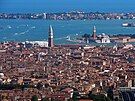
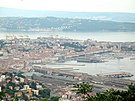
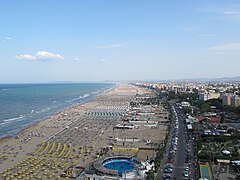
![The Barcolana regatta in Trieste, Italy, was named "the greatest sailing race" by the Guinness World Record for its 2,689 boats and over 16,000 sailors on the starting line.[264]](http://up.wiki.x.io/wikipedia/commons/thumb/c/cc/Triestebarcolana.jpg/233px-Triestebarcolana.jpg)
